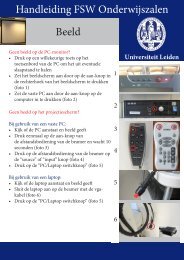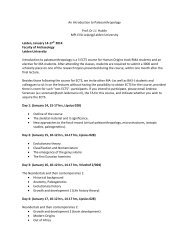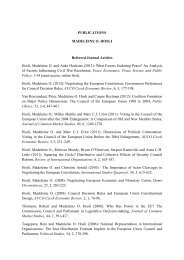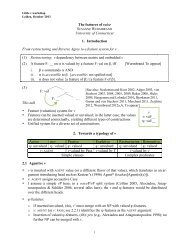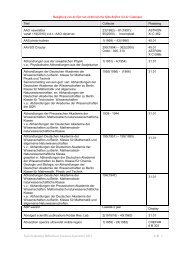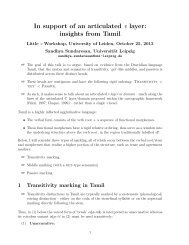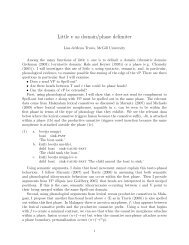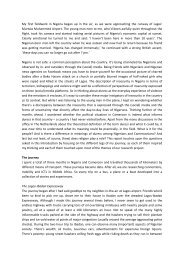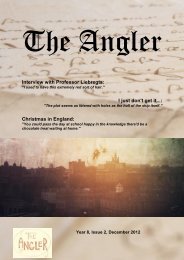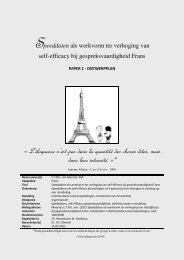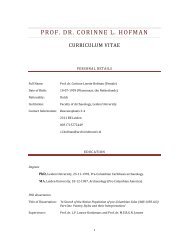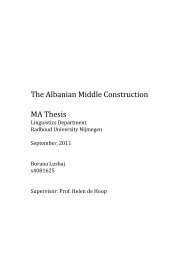here - O - Universiteit Leiden
here - O - Universiteit Leiden
here - O - Universiteit Leiden
Create successful ePaper yourself
Turn your PDF publications into a flip-book with our unique Google optimized e-Paper software.
Organisingcommitee<br />
eFourthPrescriptivism Conference2013is<br />
organisedattheUniversityof<strong>Leiden</strong>by<br />
IngridTieken-BoonvanOstade(LUCL)togetherwith<br />
TonvanHaa)en(LUCL),<br />
RikkaLänsisalmi(LUCL& LIAS),<br />
MaartenMous(LUCL)and<br />
JeroenW iedenhof(LUCL& LIAS)<br />
Conferencesupport<br />
EsrihBakker(LUCL)<br />
AnneRoseHaverkamp(LUCL)<br />
Onlineaddreses<br />
Website www.hum.leiden.edu/lucl/prescriptivism-conference<br />
Email prescriptivism-conference@hum.leidenuniv.nl
FourthConferenceonPrescriptivism<br />
Folowingthreehighlysuccesfulearlierconferences–She9eld(2003),Ragusa(2006)and<br />
Toronto(2009)–thenextConferenceonPrescriptivism ishostedin eNetherlandsby<br />
the<strong>Leiden</strong> UniversityCentreforLinguisticsin colaboration with the<strong>Leiden</strong> Institutefor<br />
AreaStudies,from 12to14June2013.<br />
e<strong>Leiden</strong>UniversityCentreforLinguistics(LUCL)engagesinteachingaswelasresearch<br />
in awidevarietyoflanguagesoftheworld,rangingfrom so-caled W estern languagestothe<br />
languagesofAfrica,Eurasiaand indigenousAm erica. e<strong>Leiden</strong> InstituteforAreaStudies<br />
(LIAS)representsm ultidisciplinaryapproachestothestudyofAsiaandtheM iddleEast.<br />
⇠eme<br />
Itisfrom thevariousresearch perspectivesem bodied in theseinstitutesthatweproposed<br />
thethem eoftheconference:PrescriptionandTraditioninLanguage.<br />
DiAerentlanguageshaveundergonediAerentstandardisationprocesesinthecourseof<br />
theirhistories.Forsom e,such asEnglish and Dutch,standard languagesdeveloped from<br />
theRenaisanceonwards,whileforotherlanguages,e.g.BasqueorIndonesian,standardisation<br />
wasinitiatedonlyrelativelyrecently.<br />
Whatevertheirdurationanddistribution,althesedevelopmentsreCectaperceivedneed<br />
forprescription,whichitselfderivesfrom linguistic,cultural,religious,ideological,political,<br />
educationalandothersources. esefactorso)enoccurincomplexcombinations;modern<br />
examplesaretheo9cialstatusofEnglishinCameroonandofM andarininTaiwan.<br />
Context<br />
isFourthConferenceonPrescriptivism isprecededbyapre-conferenceworkshop“Atitudesto<br />
prescriptivism”on 11June.Folowingtheconference,apublicsym posium entitled<br />
“W ieisdebaasoverdetaal?”(W homakestherulesinalanguage?)wilbeheldon15June.<br />
elatereventwilbemostlyinDutch.<br />
eorganisationofthisconferencehasbeensponsoredby<strong>Leiden</strong>UniversityFund(LUF),<br />
bythe<strong>Leiden</strong> UniversityCentreforLinguisticsand theNW O projectBridgingtheUnbridgeable.<br />
IngridTieken-BoonvanOstade<br />
TonvanHaa)en<br />
RikkaLänsisalmi<br />
MaartenMous<br />
JeroenW iedenhof<br />
<strong>Leiden</strong>,June2013
Pre-ConferenceWorkshop<br />
“A titudestoprescriptivism”<br />
OnTuesday11June2013,LUCLwilorganiseapre-conferenceworkshop. isworkshopis<br />
freeforalconferencedelegates.<br />
Pre-ConferenceWorkshoptheme<br />
Dra)softhepaperscirculateamongtheparticipantsoftheworkshopbeforehand. isway<br />
t<strong>here</strong>istim eforalparticipantsto read them aland prepareconstructivefeedbackforthe<br />
beneKtofthepapers’authors.<br />
isworkshopfeaturespapersthatinvestigatelanguage users’atitudes towards prescriptivism<br />
andothernorm ativeactions,prim arilyfrom thepointofview oft<strong>here</strong>cipients<br />
ofsuch actions,such asthegeneralpublic,institutionsand speciKcprofesionalgroups<br />
(linguists,journalists,educators,bloggers,etc.). efocusismainlyonEnglish,butproposalsonotherlanguagesarealsowelcome.<br />
eformatisfolows:t<strong>here</strong>are30-minuteslots,eachwith10minutesforashortpresentationofthepaper,folowedby20minutesfordiscu<br />
sionandfeedback.<br />
Pre-ConferenceWorkshoporganisers<br />
RobinStraaijer<br />
CarmenEbner<br />
ViktorijaKostadinova<br />
MoranaLukaN<br />
Pre-ConferenceWorkshopcontactdetails<br />
Website www.hum.leiden.edu/lucl/prescriptivism-conference<br />
Email prescriptivism-conference@hum.leidenuniv.nl
PROGRAMMESCHEDULE<br />
Tuesday11June<br />
14.00-17.00 Registration,room :Lipsius001<br />
Wednesday12June<br />
8.30-10.00 Registration,room :Lipsius001<br />
Pre-conferenceWorkshop:“A titudestoPrescriptivism”<br />
Venue:Lipsius,Room 148<br />
Conference:“PrescriptionandTraditioninLanguage”<br />
10.00-10.15 Conferenceopening<br />
byProf.C.J.J.M .Stolker,rectormagni4cusandpresidentoftheUniversityof<strong>Leiden</strong><br />
room :Lipsius005<br />
Plenary<br />
10.15-11.15<br />
CarolPercy,Aristocraticin↵uenceandtheEnglishprescriptivetradition:LordChester⇠eldandhisa⇡erlives<br />
Chair:IngridTieken-BoonvanOstade;room:Lipsius005<br />
11.15-11.45 COFFEE/TEA<br />
SesionsA & B MORNINGSESSION A,LIPSIUS005,CAROLPERCY<br />
11.45-12.15 HenriLePrieult,W hatdid custom m ean forthe4rst<br />
Englishgrammarians:afriendorafoe?<br />
12.15-12.45 NataliaGuermanova,A ePrincipleofIconicityin<br />
EnglishPrescriptiveGrammar<br />
MORNINGSESSION B,LIPSIUS148,R IKKA LÄNSISALMI<br />
KyokoTakashiWilkersonand DouglasWilkerson,<br />
DemocracyofSigns:PrescriptionandLibertyin<br />
JapaneseNam es<br />
12.45-14.00 LUNCH
(Wed 12 June – continued)<br />
Sessions A & B 1 ST AFTERNOON SESSION A, LIPSIUS 005, MASSIMO STURIALE<br />
14.00-14.30 Don Chapman, Prescriptive rules as a tradition in the<br />
United States<br />
14.30-15.00 Matthijs Smits, ‘Garnering’ Respect?: The Emergence<br />
of Authority in the American Usage Tradition<br />
1 ST AFTERNOON SESSION B, LIPSIUS 148, GIJSBERT RUTTEN<br />
Heimir Freyr Viðarsson, The rise of standard Icelandic<br />
syntax in the 19th century: rewriting history<br />
15.00-15.30 COFFEE/TEA<br />
Session<br />
2 ND AFTERNOON SESSION, LIPSIUS 005, ROBIN STRAAIJER<br />
15.30-16.00 Gijsbert Rutten and Rik Vosters, Negation and<br />
prescription in the history of Dutch<br />
16.00-16.30 Lars Hinrichs, Benedikt Szmrecsanyi and Axel Bohmann,<br />
Unusually strong impact of prescriptive rules on<br />
language use: The case of object-function restrictive<br />
relativizers in written standard English<br />
17.00-19.00 DRINKS, VENUE: SCHELTEMA LEIDEN, MARTSTEEG 1<br />
Thursday 13 June<br />
Plenary<br />
9.30-10.30<br />
Henning Klöter, “What is correct Chinese?” revisited<br />
Chair: Jeroen Wiedenhof; room: Lipsius 028<br />
10.30-11.00 COFFEE/TEA
(7 u13June–continued)<br />
SesionsA & B MORNINGSESSION A,LIPSIUS028,D ICK SMAKMAN<br />
11.00-11.30 MasimoSturiale,PedagogicalPrescriptivism in Early<br />
20th-centuryCo respondenceLanguageCourses.A<br />
CaseStudy:IlPoliglotaM oderno(1905-1907)<br />
11.30-12.00 KatjaLochtman,Prescriptivism and sociolinguistic<br />
competenceinGermanasaForeignLanguageatUniversity<br />
12.00-12.30 DominikBanhold,Germ an SchoolGram m arsas<br />
Norm SetingLanguageAuthoritiesinNationalistic<br />
Germanyofthe19thCentury<br />
12.30-14.00 LUNCH<br />
SesionsA & B 1 ST AFTERNOON SESSION A,LIPSIUS003,D ON CHAPMAN<br />
14.00-14.30 GabrielaE.Dima,Prescription and Tradition in the<br />
RomanianLiteraryLanguage<br />
MORNINGSESSION B,LIPSIUS148,W ENDYAYRES-BENNETT<br />
SpirosA.Moschonas,Non-uniform standards:A e<br />
caseofStandardM odernGreek<br />
ArtoMustajoki,Chalengesin thestandardization of<br />
contemporaryRu sian<br />
NadiaPetrova,A com parativeanalysisofRu sian and<br />
Englishusageguidesfrom thetwentiethandtwenty-<br />
4rstcenturies<br />
1 ST AFTERNOON SESSION B,LIPSIUS148,RIK VOSTERS<br />
HannaRutkowska,Etym ologicalspelingin thirteen<br />
editionsofTheKalenderofShepherdes<br />
14.30-15.00 CharloteBrewer,Poets,gram m arsand dictionaries DanieleCandel,Prescription and tradition,from the<br />
FrenchDictionnairedel’Académie(1635-)totheoL cial<br />
Frenchlanguageenrichmentproces(-2013)<br />
15.00-15.30 RitaQueirozdeBarros,“A higherstandard ofco rectnesthanisquitedesirable”:Linguisticprescriptionin<br />
Ostade,A ebatleofprescriptivism :FrancevsEngland<br />
WendyAyres-Bennetand IngridTieken-Boonvan<br />
Dickens’sjournals
(Thu 13 June – continued)<br />
15.30-16.00 COFFEE/TEA<br />
Session<br />
2 ND AFTERNOON SESSION, LIPSIUS 003, FELIX AMEKA<br />
16.00-16.30 Kazuhiko Nakae, From Prescriptivism to Purism in<br />
Multiglossic Arabic<br />
16.30-17.00 Loreta Vaicekauskiene, Joining scholarship and state<br />
standardization ideology: prescription as Soviet inheritance<br />
in post-soviet Lithuania<br />
19.00-23.00 CONFERENCE DINNER (registration required)<br />
Friday 14 June<br />
Plenary<br />
9.00-10.00<br />
Felix Ameka, The uselessness of the useful: between prescriptivism and practice<br />
Chair: Florian Coulmas; room: Lipsius 005<br />
10.00-10.30 COFFEE/TEA<br />
Sessions A & B MORNING SESSION A, LIPSIUS 005, MAARTEN MOUS MORNING SESSION B, LIPSIUS 148, DANIELLE CANDEL<br />
10.30-11.00 Miren Lourdes Oñederra, Basque pronunciation:<br />
dialectal richness vs. strength of the Standard in a<br />
minority language<br />
Mark Kaunisto, Guidebooks on English usage in light<br />
of corpus evidence: are the entries truly warranted?<br />
11.00-11.30 Robin Straaijer, Perspectives on Prescriptivism: The<br />
reception of English usage guides<br />
11.30-12.00 Pieter Duijf, Towards a modern Frisian Standard Viktorija Kostadinova, The Cyberstate of Language: Popular<br />
Attitudes to English Language Use on the Internet<br />
12.00-13.30 LUNCH
(Fri14June–cont.)<br />
SesionsA & B AFTERNOON SESSION A,LIPSIUS005,NATALIAGUERMANOVA AFTERNOON SESSION B,LIPSIUS148,H ENNING KLÖTER<br />
13.30-14.00 DickSmakman,Internationalde4nitionsofthe<br />
standardlanguage<br />
14.00-14.30 GiedriusTamaDeviEius,A eideologicalcontextsof<br />
languagestandardization in them edia<br />
14.30-15.00 KanavililRajagopalan,A edescriptivelinguist’s<br />
dilemmaswhenconfrontedwiththechalengeof<br />
languageplanning<br />
15.00-15.30 COFFEE/TEA<br />
Plenary<br />
15.30-16.30<br />
MartinGil,A ediscom fortofstrangers:nostalgia,<br />
ideologyand defenceoftheEnglish speech com munity<br />
DaceStrelFvica-ODiGa,Hum an-oriented prescriptivism,language-orientedprescriptivism,eror-oriented<br />
prescriptivism:somecros-culturaldiPerences<br />
FlorianCoulmas,Prescriptivism andwritingsystems<br />
Chair:TonvanHaaQen;room:Lipsius005<br />
16.30-17.00 Conferencecloses:Prof.T.vanHaaQen,director<strong>Leiden</strong>UniversityCentreforLinguistics,room:Lipsius005<br />
Saturday15June<br />
Publicsymposium (primarilyinDutch):“W ieisdebaasoverdetaal?”(W homakestherulesinalanguage?)<br />
Venue:KleinAuditorium,Academiegebouw
Plenaries<br />
in chronologicalorder
Wednesday12June,10.15-11.15<br />
CarolPercy,UniversityofToronto<br />
Aristocraticin↵uenceandtheEnglishprescriptivetradition:<br />
LordChester⇠eldandhisa⇡erlives<br />
In thisplenary,Iusethe!gureofPhilip Dorm erStanhope,thefourth EarlofChester!eld<br />
(1694–1773),to explorethesigni!canceofaristocratsto eighteenth-century English prescriptivism<br />
.<br />
LordChester!eldappearsinseveralaccountsaboutsomeearlydevelopmentsofthe<br />
tradition.In som eofthem ,hehasclearprestigeforsom esoon-to-bein2uentialcodi!ers.It<br />
iswelknown,forinstance,thatSam uelJohnson dedicated thePlan(1747)forwhatwasto<br />
behisfamousDictionary(1755)to Chester!eld.M oreover,although theelocutionistand<br />
futureorthoepist,theIrishm an 6 om asSheridan deliberatelydid notdedicatehisplan for<br />
British Education (1756)to Chester!eld,Lacking hispermision,Sheridan nevertheles<br />
beganhisplanwithan“Addres”toChester!eld,inhiscapacityastheformerSecretaryof<br />
StateforIreland(1745–46).<br />
YetotheraccountsfeatureChester!eldasasymbolofaristocrats’decliningculturallinguisticin2uence.AsSheridanwasseekingthelord’ssupportforhisplantostandardize<br />
spoken English,Johnson had becom e fam ously estranged from his prospective patron:<br />
indeed,theDictionary’ssupportby such bookselersasRobertD odsley ratherthan by patronsorinstitutionsisregardedasarepresentativedevelopm<br />
entin theprogre sofprintculture,theshi?<br />
to “m arket-driving book-m aking”.Johnson’srejection ofChester!eld wasin<br />
partareactiontosomeesaysinDodsley’speriodical eWorld,in which Chester!eld had<br />
expresedmockanxietyaboutthein2uenceon theforthcomingDictionaryofwom en and<br />
oforallanguage.Infact,whenitwaspublishedthedictionarywasinnovativelyilustrated<br />
withliteraryquotations.<br />
In oneoftheseesaysfor eWorld,Lord Chester!eld had also contrasted whathe<br />
described aspedanticand politespelings.6 isexaggerated opposition between elitemen<br />
and women wasre2ected severaldecadeslater,when somefemalereaderscriticized the<br />
masculine aristocratic valuesexpre sed in Chester!eld’spersonalletersupon the leters’<br />
posthumouspublicationin1774.Intheseleters,writenduringthe1740sandearly1750s<br />
tohisilegitim ateson,Chester!eldem phasizedthefactthatlanguageconstructsratherthan<br />
re2ectsone’sim ageandstatus.Renaisanceconductbookswouldhavem adesim ilarpoints,<br />
butinthispaperIam keentocontextualizeChester!elddeeplyandbroadlyinthe1740s,a<br />
periodpredatingtheproliferationofprescriptivegrammarsandthusseeminglykeytothe<br />
developmentofthetradition.Ishalalsodraw onandfurtherpublicizerecentresearchon<br />
such topicsasprestigein languageand historyand on t<strong>here</strong>lation ofhigh socialclasto<br />
corpus-basedaccountsoflanguagevariationandchange.
6ursday13June,9.30-10.30<br />
HenningKlöter,Georg-August-Universität,Gö tingen<br />
“W hatisco rectChinese?”revisited<br />
YuenRenChao(1892–1982)wasoneofthemosteminentChineselinguistsandlanguage<br />
plannersofthe20 th century.In hisearlycareer,heplayed an im portantrolein thedevelopmentanddocumentationofastandardMandarinpronunciation.HislandmarkGrammar<br />
ofSpoken Chinese,published in 1968,is am ong the m ost-frequently cited gram m atical<br />
overviewsofMandarin.OneofChao’sleserknowncontributionsisabriefarticleentitled<br />
“W hatIsCo rectChinese?,”published in 1961 in the Journalofthe Am erican Oriental<br />
Society.In thisarticle,Chao re2ectsupon co rectpronunciation,co recttranslationsof<br />
foreign wordsand propernam es,and co rectne sin gram m ar.Hisanalysiscenterson the<br />
early 20 th century when,forthe !rsttime in Chinese history,a nationalpronunciation<br />
standardwascodi!ed.Inthe!rstpartofmypresentation,Iwilgiveabriefintroductionto<br />
Chao’sworkinthecontextoflanguageplanninginthisperiod.Inthesecondpart,Iwil<br />
apply Chao’shypothesesconcerning “co rectChinese”to cu rentlanguagetrendsin the<br />
Chinese-speakingworld.IwilarguethatlanguageplanninginChinaa?er1949hasprovided<br />
much clearerguidelinesagainstwhich co rectnesin variousareasoflanguageuse<br />
canbemeasured.Atthesametime,however,prescriptiveguidelinesandtheirimplementation<br />
aresubjectto variousrenegotiationsand chalenges.6 esearediscu sed in thecontext<br />
ofthemarginalization ofsouthern varieties,theinternationalization ofChineselanguage<br />
teachingandagrowingdependenceofyoungspeakerson new m edia.
Friday14June,9.00-10.00<br />
FelixAmeka,<strong>Leiden</strong> University<br />
euselesnesoftheuseful:betwenprescriptivism andpractice<br />
Havinganorm maybeausefulideaandhavinganideologyaboutappropriateandcorect<br />
languageusem aybeausefulidealbutwhen itcom estolinguisticpractice,thisisusele s.I<br />
wildiscuscasesofvariousideologiescenteringonprescriptioningrammartolinguistic<br />
purism regardingisuesofcodeswitching,boroweditemsandgenerationaldiJerencesin<br />
languageuse,w<strong>here</strong>olderpeopleperceiveyoungeronesasnotspeakingwel.6 eseisues<br />
wilbediscusedinthecontextofexperiencesinlanguagedocumentationinmultilingual<br />
setingsinW estAfrica.
FlorianCoulmas,Germ an InstituteforJapaneseStudies,Tokyo<br />
Prescriptivism andwritingsystems<br />
Friday14June,15.30-16.30<br />
InthispaperIexam inetheroleofwritingsystem sinprescribingrulesoflanguage.<br />
Linguisticprescriptivism cannotbesensiblyanalysedwithoutaproperunderstandingof<br />
t<strong>here</strong>lationshipbetweenwritingandlanguagebecausewritingisboththeprincipal<br />
instrum entandtheobjectoflanguagecultivation.Setingnorm sandstipulatingusagefor<br />
writenlanguageismorecommonandmoreeJectivethanforspeech,andw<strong>here</strong>acorect<br />
pronunciation(orthoepy)isprescribeditismoreo?enlaiddowninwritingratherthan<br />
entrustedtooraltradition.However,t<strong>here</strong>lationshipbetweenwritingandspeechisa<br />
simplem appingrelationbetweengraphicalandphoneticunitsinexceptionalcasesonly.<br />
Becauseofthehistoricityoflanguageandtheasynchronouschangeofspeechandwriting<br />
thisrelationshipistypicalym oreorle scom plex.6 israisesseveralquestions:<br />
1.how diJerentwritingsystemscanbeutilizedforpurposesofprescribingusage;<br />
2.whatitisthatcanbeprescribed;<br />
3.how writingsystemsaresubjectedtoprescribednorms;and<br />
4.how prescriptivenormsthatrefertothegraphicmakeupofthesystem interactwith<br />
thoseconcerningrelationsbetweengraphicsignsandunitsoflanguage.<br />
6esequestionswilbediscusedfrom acomparativeperspectivetakingvariouswriting<br />
system sintoconsiderationinordertoelucidatehow prescriptivelinguisticnorm sare<br />
aJectedbywriting–andviceversa.
Abstracts<br />
in alphabeticalorder
WendyAyres-BennetandIngrid Tieken-BoonvanOstade,UniversityofCam bridge(UK)andUniversityof<br />
<strong>Leiden</strong>( eNetherlands)<br />
⇡ebatleofprescriptivism:FrancevsEngland<br />
6eliteratureonprescriptivism frequentlyasertsthesameapparenttruismsaboutprescriptivism<br />
inFranceandEngland.Atthebeginningofthe20 th century,thegreathistorian<br />
oftheFrenchlanguage,FerdinandBrunot(1966: I,4)claimedthat‘6 ereignofgrammar<br />
[ .]hasbeenlongerandm oretyrannicalinFrancethaninanyothercountry’,andthisidea<br />
wasrepeatedbyRodneySampsonin1993,whoclaimed‘Fewlanguageshavebeenexposed<br />
in such asustainedwaytoprescriptivein2uencesasFrench.Forthepastfourcenturies,<br />
oPcialandunoPcialbodiesandindividualshavesoughttodirectthelanguage,andmany<br />
ofthesehavecommanded,andcontinuetocommand,veryconsiderableatentionand<br />
favouram ongsttheFrench’.<br />
Discusionofprescriptivism inFrancetheno?encentresontheworkofthe17 th -<br />
centurygrammariansandremarqueurs,theroleoftheAcadémieFrançaiseandotherbodies<br />
concernedwiththeFrenchlanguage,andtheimpactoftwentieth-centurylinguisticlegislation<br />
(Ayres-Bennet2010).AsforEngland,theFrench Academ yisusualyheld upasan<br />
exampleofwhatwouldbeneededtoregulatetheEnglishlanguage:thiswasthecaseinthe<br />
early18 th century,butasim ilaratitudecan stilbefound am ongthegeneralpublictoday.<br />
Inarecentpublication,HenryHitchingswrotethat‘English-speakersaretouchy<br />
aboutquestionsofusage’(2011:4).Itisinterestingtonotethathegoesontoclaim:‘Touchines[.]isnotuncommonamongspeakersofotherlanguages,butEnglishisthemostcontestedlanguage’.AretheEnglishnow<br />
becom ingm oreprescriptiveaboutlebon usagethan<br />
theFrenchinspiteofthelackofanAcadem y?Andistheenorm ouspopularityofusage<br />
guidesintheUK today(Bu seandTieken-BoonvanOstade2011)symptomaticofthisrise<br />
in prescriptivism ?<br />
Inthispaperwewouldliketocom parethediJerenthistoricalandsocioculturalcontextsin<br />
whichprescriptivism arosein FranceandBritain,leadingtodiJerentapproachesto<br />
thesubject(e.g.t<strong>here</strong>lativeim portanceofoP cialbodiesandprivateinitiatives),andthen<br />
examinewhetherthisresultsinprescriptivism beingmanifestedindiJerentwaystoday.<br />
References:<br />
Ayres-Bennet,Wendy(2010).“SpeakingCorectly:Purism andPrescriptivism inFrance”.Festival<br />
ofIdeasLecture,CambridgeOctober2010.<br />
Buse,UlrichandIngridTieken-BoonvanOstade(2011).“TowardsaCorpusofPrescriptivism”.<br />
PaperpresentedattheHelsinkiCorpusFestival,Helsinki(Finland),September/October<br />
2011.<br />
Brunot,Ferdinand(1966)Histoiredelalanguefrançaise,vol.3.Paris:A.Colin.<br />
Hitchings,Henry(2011). eLanguageWars.AHistoryofProperEnglish.London:John M u ray.<br />
Sampson,Rodney(ed.)(1993).AuthorityandtheFrenchLanguage.Münster:Nodus.
DominikBanhold,Departm entofGerm an Linguistics,UniversityofW ürzburg(Germ any)<br />
GermanSchoolGrammarsasNorm SetingLanguage<br />
AuthoritiesinNationalisticGermanyofthe19 th Century<br />
Inthe19 th centuryGerm anydeveloped from alooselypost-Napoleonicfederation ofup to<br />
39membersintoonenationleadbyanemperor.Duringthecenturyt<strong>here</strong>wasaconstant<br />
riseinnationalism whichwasnotrestrictedtopoliticalidealslikeliberalism and<br />
constitutionalism buthadahugeimpactonthedevelopmentoftheGermanlanguagethat<br />
cannotbeoverestimated.Asitalwayshasbeen(e.g.modernEurope),thelongingforone<br />
nationbroughtuptheproblem of‘one’languagespokenbythewholenation.6 eneedfor<br />
prescriptionbecameobvious(s.Polenz1999:232).Norm bookslikegrammarsand<br />
languageguidesbecam everyproductivein thattim e(s.Klein 2003).In research,aspecial<br />
interestwaspaidtothein2uenceofsuch norm bookson theevolvingofaGerm an “leading<br />
variety”(s.Reichmann1990:141)andtothehistoryofthestigmatizationofspeci!c<br />
grammaticalforms(s.Davies/Langer2006).<br />
Inm ypresentationIwilfocusonaspecialkindofnorm books,nam elyschool<br />
grammars.W hatpositionwere19 th centuryschoolgram m arssupposed totakein the<br />
standardisationprocesoftheGerm anlanguage?6 ereisnoempiricalstudythatwouldbe<br />
abletoiluminatetheroleofgrammaticalvariantsinschoolgrammars.Basedonmy<br />
doctoraldisertationprojectIwildiscu sthreequestions:<br />
a)W hat(quantitative)roledomorphologicalvariantsplayinGermanschoolgrammarsof<br />
the19 th century?<br />
b)How arethesevariantspresented?W hatinformationisgiven?<br />
c)How arethevariantsevaluated?W hatprescriptivestrategiesareused?<br />
Givinganswerstothesequestionsisacrucialpartof!guringouttheimportanceofschool<br />
grammarsnotonlyforthestandardisationprocesoftheGermanlanguagebutforthe<br />
pasingonofcertainmorphologicalvariants,fortheformationofevaluationtraditionsand<br />
thein2uencethatpoliticalandculturaldevelopm entshaveontheim partm entoflanguage<br />
(norm )knowledge.6 elinkingoft<strong>here</strong>sultstocu rentlanguageteachingis!nalyopento<br />
discu sion.<br />
References:<br />
Davies,Winifred/NilsLanger(2006):6 eMakingofBadLanguage.LayLinguisticStigmatisationsinGerm<br />
an:PastandPresent.Frankfurt:PeterLang.<br />
Klein,WolfPeter(2003):SprachlicheZweifelsfälealslinguistischerGegenstand.ZurEinführung<br />
in ein verge senes6 em aderSprachwisenscha?.Linguistikonline16.<br />
Polenz,Petervon(1999):DeutscheSprachgeschichtevom SpätmitelalterbiszurGegenwart.19.<br />
und20.Jahrhundert(Vol.3).Berlin:deGruyter.<br />
Reichmann,Oskar(1990):SpracheohneLeitvarietätvs.SprachemitLeitvarietät.In:WernerBesch<br />
(ed.):DeutscheSprachgeschichte.Grundlagen,M ethoden,Perspektiven.Frankfurt:Peter<br />
Lang.
RitaQueirozdeBaros,FacultyofLetersoftheUniversityofLisbon (Portugal)<br />
“A higherstandardofcorrectne sthanisquitedesirable”:<br />
LinguisticprescriptioninDickens’sjournals<br />
6oughgeneralyasociatedwiththegrammaticaltraditionofthe18 th century,thebelief<br />
thatsom eform soflanguagearem oreco rectthanothers,whichJ.andL.M ilroyhave<br />
term edtheideologyofstandardization (1999),waspervasivein 19 th centuryBritain (Beal,<br />
2009).<br />
CharlesDickensworkedinthisprescriptiveseting.Itwasagainstthisbackground<br />
thathem asterlyexploiteddia-,socio-andidiolectalvariation.Togetherwithhisabilityto<br />
“deployeveryavailablelinguisticresource”(Ingham ,2008),thistraitofhisstylehasearned<br />
him theepithetsoflinguist(Quirk,1974)andsociolinguist(Pou sa,1999).<br />
ButnovelsarenotthesingletestimonyofDickens’smetalinguisticinterest.His<br />
activityasajournalistprovidesevidenceofthesamesort,ashintedbyBoltonandCrystal<br />
(1969:1)andcon!rm edinaprelim inaryanalysisofthewritingsontheEnglishlanguage<br />
publishedinHouseholdWordsandAltheYearRound(Ba ros,2012),twoweeklym agazines<br />
directedbyDickensandrecentlymadeavailableinDickensJournalsOnline(Drew,2012).<br />
6ispaperwilrevisittheabovementionedperiodicals,withtheparticularaimsof<br />
evaluatingt<strong>here</strong>levanceofprescriptivistsandprescriptivism inarticlesdevotedtothe<br />
Englishlanguage,andofdiscusingtheirexpectedlycomplexapproach(es)tosuchisue.<br />
6isanalysiswilbearinmind(i)Percy’sconclusionsonthetiesbetweenthepublishingof<br />
review periodicalsandtheriseofprescriptivism (2009)and(i)Dickens’ssophisticated<br />
senseoflinguisticappropriatenesandsubscriptionofthepo sibilityof“ahigherstandard<br />
ofco rectnesthanisquitedesirable”(Payn,1857).<br />
References:<br />
Baros,R.Q.de(2012)“DickensonEnglish:Somenon-!ctionalevidence.”Paperpresentedinthe<br />
conferenceCharlesDickensandhisTime–UniversidadeNovadeLisboa,18-20June.<br />
Beal,J.(2009)“6 reeHundredYearsofPrescriptivism (andCounting)”.InCurentIsuesinLate<br />
ModernEnglish,ed.I.Tieken-Boon van Ostadeand W .van derW urJ.Bern:PeterLang,35-<br />
55.<br />
Bolton,W.F.& D.Crystal(1969)EsaysbyLinguistsandMenofLeters.Vol2.Cam bridge:CUP<br />
Drew,J.(dir.)(2012)DickensJournalsOnline.(www.djo.org.uk)<br />
Ingham ,P.(2008)“6 eLanguageofDickens”.In ACompaniontoCharlesDickens,ed.David<br />
Paroisien.Oxford:BlackwelPublishingLtd,doi:10.1002/9780470691908.ch8.<br />
Milroy,J.&L.Milroy(1999)AuthorityinLanguage.InvestigatingStandardEnglish(3rded).<br />
London& New York:Routledge.<br />
Payn,J.(1857)OurP’sandQ’s.HouseholdWords,XVI:388,204-207.<br />
Percy,C.(2009)“PeriodicalReviewsandtheRiseofPrescriptivism:theMonthly(1749–1844)and<br />
CriticalReview(1756–1817)intheEighteenthCentury.”InCurentIsuesinLateModern<br />
English.117-150.<br />
Pou sa,P.(1999)“DickensasaSociolinguist:DialectinDavidCopper!eld”.InWritinginNonstandardEnglish,ed.I.Taavitsainen,etal.Amsterdam<br />
&Philadelphia:JohnBenjam ins,27-44.<br />
Quirk,R.(1974)“CharlesDickens,Linguist”,in eLinguistandtheEnglishLanguage.London:<br />
EdwardArnold,1-36.
CharloteBrewer,HertfordColege,OxfordUniversity(UK)<br />
Poets,grammarsanddictionaries<br />
6erelationshipbetweengreat(or‘great’)literatureandlanguagehaso?enbeenproblematic,andhasnotinfrequentlyraisedquestionsrelatingtoprescriptivism<br />
andco rectnes.<br />
SometimesithasseemedthatcanonicalauthorshavehadadeterminingeJectonthe<br />
Englishlanguage,onewhichotheruserswoulddoweltofolow.6 usHoccleveclaimedin<br />
hisRegementofPrinces(c.1412)thatChaucerwasthe‘!rstefyndere[i.e.inventor]ofour<br />
fairelangage’,andLydgate(LifeofOurLady,c.1416)explained thatthenatureofthis<br />
contributionlayinthespeci!calyliterarycharacteristicsofChaucer’slanguage:<br />
AndekemymaisterChaucerisygrave<br />
6enobleRethor,poeteofBrytayne<br />
6atworthywasthelaurertohaue<br />
Ofpoetrye,andthepalmeateyne<br />
6atmade!rste,todistileandtorayne<br />
6egoldedewe,dropes,ofspecheandeloquence<br />
Intoourtunge,thurghhisexcelence<br />
Andfondethe2oures,!rsteofRhetoryke<br />
OurRudespeche,onlytoenlumyne<br />
6atinourtunge,wasnevrenoonhym like.<br />
Hundredsofyearslater,J.H.Newmanalsoobservedthatgreatwriterscrucialyin2uenced<br />
thelanguageofeveryoneelse,describinghow the‘sayings’of‘agreatauthor.pa sinto<br />
proverbsamonghispeople,andhisphrasesbecomehouseholdwordsandidiomsoftheir<br />
dailyspeech,whichisteselatedwiththerichfragmentsofhislanguage’(Ideaofa<br />
University,1873).<br />
Atthesametime,however,thoseconcernedwithmakinggrammarsanddictionaries<br />
haveo?encriticizedthelanguageofsuchwriters.JohnsonquotedPope,Drydenand<br />
Addisonhundredsoftimesinhisdictionary,butcensoredthem forwhathecaled<br />
‘Barbarous,orim pure,wordsand expre sions’;Lowth repeatedlycited Shakespeare,M ilton,<br />
Pope,Addison,Prior,andDryden(amongothers)inhisGrammarasexamplesofpoor<br />
usage(asdiscu sedinstudiesbyPercyandTieken-BoonvanOstade);andtheOED,<br />
althoughitseditorJ.A.H.M u rayspeci!ed‘althegreatEnglishwritersofalages’asthe<br />
mainsourcesforthatgreatdictionary’sstockofover!vemilionquotations,occasionaly<br />
markedexamplesoftheirusageas‘catachresticoreroneous’,proscribingthem witha<br />
specialsymbol(theparagraphm ark).6 ispaperexam inessom efeaturesofthewaythat<br />
recordersoflanguagehaverespondedprescriptivelyorproscriptivelytotheworksof<br />
creativewriters,lookingbothatwhattheyhavesaidaboutsuchwritersandathow they<br />
haveregisteredthelanguageofpoets,novelistsetcintheirownworks.
UlrichBu se,M artin LutherUniversity,Hale-W itenberg(Germ any)<br />
⇡enativespeakerisdeadvs.⇡enativespeakerisalive:<br />
WhosenormsdoELFsneed?<br />
TheglobalspreadofEnglishhasledtotheconceptionofanumberofmodelsaccountingfor<br />
them anyform sandfunctionsofEnglishintheworld(seeM cArthur1998:Ch.4).Even<br />
thoughitisabitoutdated,theKachruvianm odelwithitsso-caledthreeconcentriccirclescan<br />
serveasastartingpoint.Traditionaly,intermsofnormsthem othertonguecountries,w<strong>here</strong><br />
Englishisspokenasanativelanguage[ENL]areregardedasnorm-providing,thecountries<br />
andareas,w<strong>here</strong>Englishhasthestatusofasecondlanguage[ESL]asnorm-developing,and<br />
thecountriesoftheexpandingcircle,inwhichEnglishistaughtasaforeignlanguage[EFL],as<br />
norm-dependant.<br />
Gnutzmann(2012:315)observesthatwhiletheconceptofStandardEnglishhas<br />
beencriticizedbylinguistsandeducationalistsintheUK,“itsusefulnesasamodelforthe<br />
teachingofEnglish asaForeign Language(EFL)wasnotaJectedbysuch considerations,and<br />
wasverymuchtakenforgranteduntilafewyearsago.”<br />
However,overthepasttento!?eenyears,academicinterestintheuseofEnglishasa<br />
linguafranca[ELF]hasgrown.6 edevelopm entofaspecialcorpus,caledVOICE[= Vienna-<br />
OxfordInternationalCorpusofEnglish],byBarbaraSeidlhofer,andarecentlyestablished<br />
academicjournal[=JournalofEnglishasaLinguaFrancawitha!rstisueinMarch2012]<br />
testifytotheliveline softhisnew researcharea.In thefram eworkofthisresearch,doubtshave<br />
beenraisedastowhetherStandardEnglishandhencenativespeakernormsarestilvalid<br />
modelsforEFL(andESL).<br />
Inarecentarticle,BarbaraSeidlhofer(2012:79)discu sesasoneveryprom inentexampletheuseoftheprepositionaboutfolowingtheverbdiscus,!ndingthatsuch<br />
aconstruction<br />
isusedwidelyin ELFinteractions,butthatdictionariesandgram m arspurportingto<br />
addresadvancedlearnersofEnglishandtheirneeds,“includingthosebasedon‘international<br />
corpora’,emphasizehow eroneousthisusageis.6 eOxfordAdvancedLearner’sDictionary<br />
oJersa‘Help’noteundertheentrydiscusanddriveshomethemesagegraphicalywith<br />
strike-outfont:Youcannotsay‘discu saboutsom ething’:‘Idiscu sed aboutm yproblem with<br />
myparents’.”<br />
6epointofdepartureofthepaperathandistoinvestigateaselectionofrecentlearner’s<br />
dictionariesandgrammarsandtoscrutinizehow theyhandlesimilarcasestodiscovertheir<br />
practice(andtheunderlyingnorms)andthenask(andposiblyanswer)thefolowing<br />
questions:<br />
–Couldandshouldtheyimplementother(i.e.non-native)norms?<br />
–Canthesebeabstractedasastatisticalnorm from acorpussuchasVOICE?<br />
–How shouldadictionaryentryre2ectingELF-normslooklike?<br />
References:<br />
Gnutzmann,Claus(2012):“TeachingEnglishinaGlobalisedWorld:DoesitMakeaDiJerence?”In:<br />
Schröder/Bu se/Schneider,eds.,315-327.<br />
McArthur,Tom (1998): eEnglishLanguages.Cam bridge:CUP.<br />
Schröder,Anne,UlrichBu seandRalfSchneider,eds.(2012):Codi⇠cation,CanonsandCuricula.<br />
DescriptionandPrescriptioninLanguageandLiterature.Bielefeld:Aisthesis.<br />
Seidlhofer,Barbara(2012):“6 eChalengeofEnglishasaLinguaFranca”.In:Anglistik:International<br />
JournalofEnglishStudies23.1:73-86.
DanieleCandel,CNRS(H TL)/UniversitéParisDiderot–Paris7,Paris(France)<br />
Prescriptionandtradition,from theFrenchDictionnairedel’Académie<br />
(1635-)totheo8 cialFrenchlanguageenrichm entproce s(-2013)<br />
Linguisticdiversityandlinguisticenrichmenthavebeenproblematicforgrammariansand<br />
linguistsinvolved in lexicographyorterm inology,and forgovernm entsaswel.Franceisa<br />
goodexample,astheFrenchAcademy(“Académiefrançaise”)wasoPcialyestablishedin<br />
1635withthetaskofactingasanoPcialauthoritywithregardtolanguage.Animportant<br />
isuein com m unication being,attheendofthe20 th and thebeginningofthe21 st centuries,<br />
thedevelopm entofscienti!candtechnicallanguage,oP cialrecom m endationsdealingwith<br />
usageofscienti!candtechnicalwordsareregularlybeingpublishedbytheFrenchState.<br />
6eserecommendationsorprescriptionsoriginatefrom the“Frenchlanguageenrichment<br />
proces”(“procesusd’enrichisementdelalanguefrançaise”,1996-),inwhichspecialistsof<br />
diJerent!eldsandlinguistsacttogether,mostlyinordertoproposeandrecommend<br />
FrenchwordsinsteadofAnglo-americanloan-words,inanoPcialmanner.Itis<br />
noteworthythatsomeactorsofthe“Frenchlanguageenrichmentproces”team arealso<br />
partoftheteam helpingconstructingtheFrenchAcademyDictionary(Dictionnairede<br />
l’Académ ie)inits9 th edition.Itisalsoworth underliningthattheAcadem yonlyrecently<br />
begantogiveexplicitprescriptions,inits9 th ongoingedition;theAcadem yeven publishes<br />
theseprescriptionsseparately.InpointingouttheevolutionoftheDictionnairede<br />
l’Académ iein itsprescriptivetradition,weplan todiscu safew resem blancesbetween the<br />
FrenchAcademictradition(1635-)andtheFrenchlanguageenrichmentproces(1996-)<br />
andanalyset<strong>here</strong>spectiveprescriptionactivitiesofbothinstitutions,aswelastheirresults.<br />
WewilalsoshowhowtheoldFrenchprescriptivetraditioniscontinuouslyimproving.<br />
References:<br />
Candel,D.,2010,«Dénommeretdé!nirenlexicographieetenterminologie»,L’Archicube9,114-<br />
121.<br />
Caput,J.-P.,1986,L'Académiefrançaise,Co l.«Q uesais-je?»,Paris,PUF.<br />
FranceTerme,TouslestermespubliésauJournaloL cielparlaCommisiongénéralede<br />
term inologie,htp:/franceterme.culture.fr/FranceTerme/<br />
Quemada,G.,1997,«Neuvièmeédition1986-1992,PréfaceetAvertisement»,dansB.Quemada,<br />
dir.,LesPréfacesduDictionnairedel’Académiefrançaise1694-1992,Paris,Cham pion,453-<br />
508.<br />
Rey,C.,2011,«Les‘Recommandationsnormatives’delaneuvièmeéditionduDictionnairede<br />
l’Académ iefrançaise»,Carnetsd’AtelierdeSociolinguistique5,59-82.<br />
Rey,C.,2011(ed.),«LeDictionnairedel'Académiefrançaise:unmodèlequitraverselessiècles»,<br />
Étudesdelinguistiqueappliquée163.
DonChapman,Brigham YoungUniversity,Provo,Utah(US)<br />
PrescriptiveRulesasaTraditionintheUnitedStates<br />
Prescriptiverules,astheyhavebeencodi!edinusagehandbooksandtaughtinschoolsin<br />
theUnitedStates,havecom etoconstitutetheirowntradition.Som eprescriptiverules,like<br />
lesvs.fewerorim plyvs.inferhavebeen pa sed on from handbooktohandbookand from<br />
teachertostudenttothepointthattheirbelongingtoacanon ofusagerulesm aywelhave<br />
becomeasimportantasanyoriginalreasonforpromotingtheserules.Knowingthem<br />
cariesmuchvalueinitself.InBourdieu’sterms,theyconstitutesymboliccapitalthatcanbe<br />
convertedintoculturalandeconomiccapital(1991).IneJect,thetraditionofprescriptive<br />
ruleshasbecom eanimportantsourceofauthorityforindividualprescriptiverules.How<br />
thattraditionworksasatraditionwilbethesubjectofthispresentation.<br />
6etraditionalnatureofprescriptiveruleshasbeenfrequentlyremarked(Petersand<br />
Young1997;Meyers1995;Algeo1992).W hatdeservesmoreatentionisthewaythatthe<br />
workingsofatraditionconfervaluetotheknowledgetransmitedinthattradition.An<br />
im portantroleoftradition,assuggestedbytheword’setym ology,istopa son item sof<br />
im portance,in thiscase,theprescribedandproscribedvariantsofseveralconstructions.In<br />
thisaction,atraditionm ustbeatoncestableand2exible.Itm ustappeartobestable<br />
enoughforrecipientstotrustthevalidityofthetransmiteditems,yet2exibleenoughto<br />
accommodatenew informationandneeds.Somewaysthattraditionsmanagethese<br />
contradictoryimpulsesaretoreifythetransmitedinformationandtopresentnew<br />
inform ation within theestablishedgenresandform ulations.New inform ation isnot<br />
presentedasnew information,butinsteadasanelaborationofwhathasalreadybeen<br />
accepted.<br />
Intherhetoricoftheprescriptiverules,thesestrategiesareevident.W ithsom e<br />
notableexceptions(Meriam-Webster1994,Peters2004),theprescriptiverulesinmost<br />
usagehandbooksarepresentedasiftheirjudgmentswerealreadyestablishedandnot<br />
subjecttoscrutiny.Yetthetraditionitselfism oredynam icthanthisrhetoricwouldsuggest,<br />
asnew rulesareadoptedandsomeoldonesdiscarded,withlitleexplicitnotice.By<br />
perpetuatinginformationasifitwerealreadyandalwaysaccepted,theprescriptive<br />
traditionacquiresstrongstayingpower.6 ispaperwildraw uponspeci!cprescriptive<br />
rulesfrom varioususagehandbookstoilustratetheworkingsofthistraditionintheUnited<br />
States.<br />
References:<br />
Algeo,John.1991.SweetaretheUsesofDiversity.Word(42):1-17.<br />
Bourdieu,Piere.1991.LanguageandSymbolicPower.Ed.John B.6 om pson.Trans.Gino<br />
RaymondandMathewAdamson.Cambridge:PolityPres.<br />
Meriam-WebsterDictionaryofEnglishUsage.1994.Spring!eld,M A:M e riam -W ebster.<br />
Meyers,WalterE.1995.“LinguisticsinTextbooks:AForty-YearComparison”AmericanSpech<br />
(70):30-68.<br />
Peters,Pam.2004. eCambridgeGuidetoEnglishUsage.Cam bridge:Cam bridgeUniversityPre s.<br />
Peters,Pam andWendyYoung.1997.EnglishGrammarandtheLexicographyofUsage.Journalof<br />
EnglishLinguistics(25):315-31.
GabrielaE.Dima,SectiadeItaliana,Universitatea“Al.ICuza”,IaOi(Rom ania)<br />
PrescriptionandTraditionintheRomanianLiteraryLanguage<br />
6ispaperintendstopresentsomepeculiaritiesofthelinguisticsystem ofRomanianinits<br />
historicaldevelopment,withparticularregardtothe18 th century.<br />
OldRomanianreachedarelativelyunitarycharacterby1750.Laictranslations<br />
cariedoutduringthefolowingperiod,whichrepresenttheonlyform oflaicliteraturein<br />
Romanian,werein2uencedbyWesternEnlightenmentandalowedthepenetrationof<br />
severalelem entsfrom thepopularlanguagewhileextendingthenumberofinnovations.<br />
AccordingtoEugenioCoseriu(Introducereinlingvistica,Cluj,1975),ataparticularm o-<br />
ment,someinfrequentphenomenaareseenas“erors”bytheoldsystem consideredto<br />
representthe“prescription”,buttheybecom einnovations,endingtobeacceptedasregular<br />
elementsofthenew system.<br />
Wewilt<strong>here</strong>forepresentasigni!cantnumberofexamples,extractedfrom the<br />
RomanianCyrilicmanuscriptsthathavebeenlitleinvestigatedsofar,toilustratethe<br />
linguisticchanges,t<strong>here</strong>asonsbehind thesechangesand their!nalacceptanceasprescriptiveelem<br />
ents.Am ongthenum eroussituationsencountered,weshalprovideexamples<br />
atphonetic,morphologicalandlexicallevel.Forinstance,inphonetics,theoldlanguage<br />
usedtheverbalform adePchide,whilein the18 th centurya“mistakenform”,adeschide,<br />
appeared,generalizedandbecamecompulsoryinthemodernliterarylanguage.Asfaras<br />
morphologyisconcerned,articledformsoft<strong>here</strong>lativepronouncare,speci!ctotheold<br />
language(carea,carele,cari),wereabandonedinfavouroftheunin2ectedform .Lexical<br />
wavingbetweentraditionandinnovationisparticularlyspectacular.6 echangeinthe<br />
!eldsofinterestduringEnlightenmentdeterminedthedevelopmentoffunctionalstyles<br />
andimposedanincreaseinthenumberofneologisms,necesaryforanadequatecommunication.6<br />
us,t<strong>here</strong>tookplacesigni!cantchangesofvocabularywithinanevolutionincludingtwophases.6<br />
e!rstneologismshadaphoneticadaptationandamorphological<br />
determinationaccordingtothetraditionalneo-Greekin2uence.Asaresult,togetherwith<br />
Greekwordssuchasdiadoh,ipocrisis,itichi,ametahirisi,perierghie,tropos,Latin-rom ance<br />
loanswereadapted in thesam eway:apublicarisi,arecomandarisi,atradisi,teoreticos.6 e<br />
secondphasem eantadeparturefrom theprevioustraditionsthatcouldnot,however,be<br />
substitutedbyadiJerentnorm .6 econsequencewasthatthephoneticaspectoftheloan<br />
waspreserved,makingthusposibleanimmediateidenti!cationofthesourcelanguage:<br />
academisian,meta⇠zisian,pansion,senser(from French),arhivum,consilium,presidens,<br />
universitas(from Latin),calitá,neutralitá,prigionier,stravaganRS(from Italian),etc.<br />
6elanguageevolution,thecommoneJortsoftheRomanianintelectuals,the<br />
establishmentofaprescriptivegrammaranddictionary,thesubstitutionoftheCyrilic<br />
alphabetwiththeLatinoneconditionedtheformationofthemodernRomanianLiterary<br />
language.
PieterDuij,FryskeAkadem y–KNAW ,Departm entofLinguistics,L euwarden ( eNetherlands)<br />
TowardsamodernFrisianStandard<br />
Frisian,theGermaniclanguagespokeninthenorthernDutchprovinceofFriesland,has<br />
forcenturiesbeenmainlyaspokenlanguage.Sinceabout1900thewritenuseofFrisian<br />
hasincreased,foralargepartduetotheso-caledFrisianM ovement.6 is,consistingof<br />
individuals,groupsandinstitutions,hassincethenineteenthcenturybeenendeavouring<br />
tostrengthenthepositionofthem inoritylanguageintheNetherlands.(About55% ofthe<br />
inhabitantsoftheprovinceofFrieslandhasFrisian astheirm othertongue;almostal<br />
FrisiansspeaksandwritesDutchperfectly).Inthelastdecadeofthetwentiethcentury<br />
FrisiangotthestatusofthesecondoPciallanguageoftheNetherlands.W hilesincethe<br />
RenaisanceinWesternEuropeLanguagebuildershavebeenmakingeJortstostandardise<br />
languages,standard languagesbecam eaccepted generaly.6 estandardisation proce sof<br />
FrisianwasdiJerentanditstilis(Feitsma(1989);Breuker(2001).6 estandardforFrisian<br />
hasnotcrystalizedoutyet(DuijJetal2008).Inpractice,thismeansthatseveralvariant<br />
form sandpronunciationsareaccepted.6 isin spiteofthehundredyearsoldhistoryof<br />
Frisiandictionaries.Alsointhenineteenthcenturythe!rstmoreorlesoPcialFrisian<br />
orthographyruleswerepublished.ButliketheFrisianstandardtheserulesarenotfuly<br />
prescriptive.Frisiansdon’thaveaspelingguideliketheDutchGroeneBoekje.However,<br />
sincethebeginningof2012thelinguisticdepartm entoftheFryskeAkademyisworkingon<br />
thecom pilingofastandardwordlistoftheFrisianlanguage.A wordlistwithstandard<br />
orthographyrules.6 echoiceforastandardwordlist,impliesthatthecompilershaveto<br />
makealotofchoicesmore.Whichdialectform hastoreceiveaplaceinthedictionaryand<br />
whichnot?Orisitnecesaryordesirabletogivetwoorevenmorevariantsaplaceinthe<br />
guide?<br />
Inm ycontributionIwanttodescribewhatworkhastobedoneonastandardfor<br />
Frisian.IwanttodothisonthebasisofdiJerencesbetweenthevarietyofFrisiandialects.<br />
Ofcourse,sincethewritingtraditionofFrisianalotofstandardizationchoiceshavebeen<br />
made,andIwanttodescribewhyjusttheseweremade.Isthistraditionalwaysleadingfor<br />
thecom pilersofthenew standardwordlist,ordotheyhavetom aketheirownchoices?<br />
References:<br />
Breuker,P.(2001),‘6 eDevelopmentofStandardWestFrisian.’InHorstH.Munskeetal,HandbuchdesFriesischen/HandbookofFrisianStudies.Tübingen:M<br />
axNiem eyerVerlag.711-721.<br />
DuijJ,P.;VanderKuip,F.;DeHaan,R.;Sijens,H.(2008).FryskHânwurdboek.Ljouwert:Fryske<br />
Akademy,AFUK.<br />
Feitsma,A.(1989).‘6 eHistoryoftheFrisianLinguisticNorm’.InFodor,I;Hagège,C.(eds.).LanguageReform,HistoryandFuture/LaRéformedesLangues,HistoireetAvenir/Sprachreform,GeschichteundZukun⇡4.Ham<br />
burg:Helm utBuskeVerlag,Ham burg.249-272.
MartinGil,ÅboAkadem iUniversity,Turku (Finland)<br />
⇡ediscomfortofstrangers:nostalgia,ideology<br />
anddefenceoftheEnglishspeechcommunity<br />
SpeakingtoConservativepartymembersin2011,BritishPrimeM inisterDavidCameron<br />
highlightedthe“discomfortanddisjointednes”experiencedbyinhabitantsof“real<br />
communities”facedwithanin2uxof“new people”unabletospeaktheirlanguageand“not<br />
realywantingorevenwilingtointegrate”.<br />
Hismesagewasalsoclearlyaimedatawiderandnow increasinglyvocalBritish<br />
audience,hostiletomulticulturalism ,scathingaboutperceived‘politicalcorectnes’–<br />
whowouldconcurwiththemotion proposedin aSpectatordebateattheRoyalGeographicalSocietyin<br />
M arch2012that,regardingimmigration,“Enoughisenough”<br />
(cariedby178votesto85).<br />
Underpresurefrom populardiscoursesdominatedbysuchviews,m anycountries<br />
arewitnesingt<strong>here</strong>surgenceofmonoculturalideologies,including(re)enforcementof<br />
regulatedlanguagenormsandanincreaseddeterminationtoregardthenationalpolityas<br />
stable,hom ogeneousandmonolingual.<br />
Cameron’scommentsreflectapolicyworldshapedbyandresponsivetosuch<br />
asumptions,w<strong>here</strong>theintegrityoftheEnglishspeechcommunityisnow seentobein<br />
urgentneedofdefence.Atthesametime,hisimageofhom ely,plain spoken,monoglot<br />
Britainoverunbydangerouslyincom prehensibleoutsidersbelongstoafam iliartradition<br />
ofnationalrhetoricalself-imagining.Drawingonananalysisofexamplesfrom recent<br />
British politicalandmediadiscourse,thispaperwilexaminecu rentmanifestationsof<br />
thistradition,inparticularitsuseindiscursiveboundarymaintenance,norm enforcement,andt<strong>here</strong>sultingpositioningof‘others’inrelationto‘Britishnes’/‘Englishnes’.<br />
ItwilsuggestthatspeakingEnglishplaysakeyrole:atonceasimplerequirement<br />
andanimposibleideal,aclosedcategorythat“newpeople”arenotautomaticalyfreeto<br />
join,eveniftheyareunderrelentlespresuretodoso,andeveniftheirnotjoiningis<br />
interpretedasanactivechoiceontheirpart,henceproofofunsuitability.<br />
6atsuchviewscanbemaintainedinthefaceofaneverydayrealityin which m ultilingualandmultiethnicidentitiesareincreasinglythenorm<br />
suggeststhatwhatisneededis<br />
acriticalyinform edchalengetothebasisoftheseexclusivediscoursesthemselves.
NataliaGuermanova,M oscow StateLinguisticUniversity(Ru sia)<br />
⇡ePrincipleofIconicityinEnglishPrescriptiveGrammar<br />
Criticsofprescriptivetraditiono?enclaim thatoneofitsmainfalacieswas,togetherwith<br />
theexce sivefocusonsocialprestigeandasubjectiveapproachtostandardization,thelack<br />
ofatheoreticalbasis.However,acloselookatprescriptiverulesshowsthatthe18 th century<br />
prescriptivegrammarandthephilosophicaltraditionofthetimehavemanymorepointsof<br />
intersection than itiso?en believed.<br />
6eunderlyingprincipleofprescriptivism,basedonLocke’sconceptoflinguistic<br />
sign,wastheisom orphism oflanguageandthought.Itwasbelievedthatiflanguagewas<br />
usedimprecisely,itdistortedthemeaningthespeakerwastryingtoconvey,whichresulted<br />
in “thecheatofwords”.Consequently,m anyprescriptivestricturesm adeuseofthedistinctionsbetween<br />
gram m arform stoenablespeakerstoexpre sasm anysubtlesem anticnuancesaspo<br />
sible.6 ewel-knownexamplesarerulesconcerningagreementbetweensubject<br />
andpredicate,wordorder,theuseofarticles,diJerentiatingpartsofspeechandformsof<br />
iregularverbs,theprohibition tousethatin relativeclausestodistinguish them from<br />
objectclausesetc.<br />
Viewed inasemioticperspective,theserulesledto theincreaseindiagrammatic<br />
iconicityin StandardEnglish.6 us,m any(perhapsm ost)gram m arruleswerebasedon<br />
fundam entalprinciplesoficonicity,whichclaim thatdiJerentconceptsareexpre sedby<br />
diJerentforms(diJerentiationprinciple),similarconceptsareexpresedbysimilarforms<br />
(analogyprinciple),wordorderindicatesrealorconceptualdistancebetweenreferentsor<br />
theirpragm aticvalue(proxim ityprinciple)etc.AccordingtoNaturalne shypothesis<br />
(T.Givon,J.Haiman,W.Dreslerandothers)iconicsignsareseenasmorenaturalthan<br />
arbitraryones.Ifthisisrealyso,theaccentoniconicityinprescriptivegrammarcouldbe<br />
seenasnotsoarti!cialasitiso?enstated.<br />
6egrowingcriticalatitudetoprescriptivegrammarinthe19 th centurycan beexplained,amongotherfactors,bytheshi?inthephilosophicalcontext,as,beginningwith<br />
theepochofRom anticism ,Locke’sconceptoflinguisticsigngavewaytoHum boldtian<br />
viewsonlanguage.Humboldtunderstoodlanguageasapowerfulcreativeforce,shapingthe<br />
geniusofthenation.Hedevelopedanew conceptionofperspicuity,whichwasnomore<br />
seenasanobjectivepropertyoftext,butratherasashi?ingpsychologicalfactor.6 usthe<br />
discrepancybetweenlanguageandthoughtemergedasanintegralantinomyofhuman<br />
communicationwhichwasnottobecorectedbyman.NeithercouldSchleicher’sorganic<br />
conceptoflanguageasanaturalphenomenonindependentofman’swilserveasatheoreticalbasisforstandardization.W<br />
henprescriptiveruleslosttheirtheoreticalgrounding,<br />
theybegantoberegardedaspurelyform alandsuper2uous,whichexplains,ifpartialy,the<br />
criticalatitudetoprescriptivetraditioninmodernlinguistics.
LarsHinrichs 1 ,BenediktSzmrecsanyi 2 andAxelBohmann 1 , 1 UniversityofTexasatAustin(USA),<br />
2UniversityofManchester(UK)<br />
Unusualystrongimpactofprescriptiverulesonlanguageuse:<br />
⇡ecaseofobject-functionrestrictiverelativizersin writenstandardEnglish<br />
Whilethein2uenceofgrammaticalprescriptivism onactuallanguageuseisgeneralyconsideredtobeweak,thecaseofrelativizerselectioninStandardEnglishrestrictiverelative<br />
clausesprovidesastrongcounter-example.Inthelate20thandearly21stcenturies,variation<br />
between thethreepo sibleform sisnolongerfreefrom prescriptivein2uence.M ost<br />
writersnowhaveastylisticpreferencebetweenwhich,that,and zeroin asentencelike is<br />
isthehouse___Jackbuilt.In theprescriptiveusageliterature(e.g.Fowler,1965;Strunk&<br />
White,1999),theoptionthathasbeenstronglypropagatedsincetheearly20 th century.O ur<br />
papertakesacorpus-based,statisticalapproachtothiscaseofvariation.<br />
Inordertobeterunderstandwhythisparticularprescriptionhasgainedsom uch<br />
groundinwritenStandardEnglishwhileothershavenot,wetapthepart-of-speech-tagged<br />
Brownfamilyofcorpora(Hinrichs,Smith,& Waibel,2010)inamultivariateapproach.<br />
Usingsemi-automatedproceduresofdata-extractionandcoding,wecompiledadatasetof<br />
N=6,061objectrelativeclausesfrom BritishandAmericanEnglish,publishedinequal<br />
amountsinthe1960sandthe1990s.W eapproachedthechoicebetweenwhich,thatand<br />
zeroast<strong>here</strong>sponsevariable(casesofwho(m)(se)-,w<strong>here</strong>-andwhyasrelativizerswere<br />
excluded)andcodedeachoccu renceformorethanfortyindependentfactors.6 ese<br />
includenotonlytheusualfactorsrelatedtolinguisticcontextsuch asthepartofspeech of<br />
theantecedent,orthem ostrecentselectionofrelativizerm adebythesam ewriter(totest<br />
form orphosyntacticpersistence),butalsothefrequencyofotherfeaturesthatarethe<br />
subjectofprescriptivistdiscourse.Forexample,wequanti!edforeachcorpus!lethe<br />
proportionofverbsinpasivevoicevs.active,strandedprepositionsasproportionofal<br />
prepositionsused,thefrequencyofsplitin!nitivesandtheuseofshalversuswilasmodal.<br />
Weanalyzedthedatausingunivariateanalysis,multilevellinearmodeling,multilevel<br />
logisticregre sion,and random forestm odeling.Our!ndingsare:(1)Changein usage<br />
betweenthe1960sand90sismanifestedasadramaticdropinthefrequencyofwhichselection,m<br />
ostlyinfavorofthatbutalsoofzero.Inotherwords,theprescriptivistrulehas<br />
eJectivelyamountedtowhich-proscription.(2)Otherareasofgram m arthatprescriptivism<br />
hastriedtoin2uence(e.g.pasivevoiceproscription)havealsochanged,sometimesalonga<br />
sim ilartrajectory.However,analysisatthelevelofdiJerenttextualgenresfailstoshow<br />
co relation.W eproposethatthese!ndingspointtowardthestrongidiosyncrasyof<br />
individualprescriptiverules.<br />
References:<br />
Fowler,H.W.(1965).ADictionaryofModernEnglishUsage.(E.Gowers,Ed.)(Reprint.).ClarendonPres.<br />
Hinrichs,L.,Smith,N.,&Waibel,B.(2010).Manualofinformationforthepart-of-speech-tagged,<br />
post-edited“Brown”corpora.ICAM E Journal,34,189–231.<br />
Strunk,W.,& W hite,E.B.(1999). eElementsofStyle(4thed.).Longm an.
MarkKaunisto,UniversityofJyväskylä(Finland)<br />
GuidebooksonEnglishusageinlightof<br />
corpusevidence:aretheentriestrulywarranted?<br />
6ispaperlooksintoEnglishguidebooksonlanguageuse,withspecialatentiongivento<br />
thequestionoftheselectionofitem sastheirentries.Suchreferencebookshaveingeneral<br />
shownvaryingdegreesofprescriptivenes;forexample,asrem arkedbyCrystal(2009),<br />
som eofthecom m entariesinFowler’sclasicADictionaryofModernEnglishUsage,originalypublishedin1926,maybecharacterisedasprescriptive,w<strong>here</strong>asothersaremore<br />
descriptiveandacceptingofperceivedchangesinthelanguage.Itisonlyfairlyrecentlythat<br />
referencebooksonlanguageusehavebeenconsciouslyputtogetherbym akinguseoflarge<br />
databasesofauthentictexts,notableexamplesbeingtheworksbyGarner(1998)andPeters<br />
(2001).6 eanalysisofauthenticcorpusdataprovidesam oreobjectiveviewpointintothe<br />
isuesconcerninglanguagevariation andchange.<br />
Consideringguidebooksingeneral,wemaystilaskwhatkindsoffactorshaveledto<br />
theselectionofentriesinthem :althoughthedescriptionsm adeintheentriesm ay<br />
nowadaysbebasedonstudiesofauthenticdata,whyhavetheauthorschosentocoverthose<br />
particularquestionsaboutlanguageuse?AsChapman(2009)hasobserved,tradition<br />
probablyplaysanimportantpartinthesetupoftheentries.Ontheotherhand,itisevident<br />
thatatsom epointcertainisueslosetheirrelevance,resultingfrom eitherclearlanguage<br />
change(e.g.,undesiredformsorexpresionsarenolongerused)ormorewidespread<br />
acceptanceoftheusesearlierregardedassubstandard.A goodexampleoftheeJectof<br />
traditionisthecoverageofsplitin!nitives:althoughtheyarenowadayscom m only<br />
accepted,theisueisstilo?endiscu sedinusagemanuals.<br />
Mypaperexaminestheentriesinvolvingrivalwordswhichsharethesamerootbut<br />
havediJerentsuPxes.Suchitemsarefrequentlycommentedoninguidebooksonlanguage<br />
use.6 estudyfocusesontwosuPxpairs–wordsendingin-ic/-icaland-ive/-ory–and<br />
observestheoccu rencesofentriesintenguidebooks(publishedinthelast20years)in<br />
lightofthefrequenciesofco respondingrivalword pairsin largeelectroniccorpora,the<br />
100-milion-wordBritishNationalCorpusandthe450-milionwordCorpusof<br />
ContemporaryAmericanEnglish.Althoughmerefrequencydatadoesnotfulyexplain<br />
whydiJerentexpresionsarediscusedinguidebooks,thestudyaskswhethercertain<br />
paterns(suchasrivalsuPxpairs)orindividualwordpairstendtodraw moreatention,<br />
relativelyspeaking,thantheywouldappeartodeservebasedoncorpusevidence.<br />
References:<br />
Chapman,Don(2009)“Lostbatlesandthewrongendofthecanon:atritionamongusageprescriptions”,apaperpresentedattheSHEL-6conference,BanJ,Canada,April30-M<br />
ay2,<br />
2009.<br />
Crystal,David(2009)IntroductiontoADictionaryofModernEnglishUsage:theClasicFirst<br />
EditionbyH.M .Fowler,editedbyDavidCrystal.Oxford:OxfordUniversityPres.<br />
Garner,Bryan(1998)ADictionaryofModernAmericanUsage.Oxford:Oxford UniversityPre s.<br />
Peters,Pam (2001) eCambridgeDictionaryofEnglishUsage.Cambridge:CambridgeUniversity<br />
Pres.
ViktorijaKostadinova,LUCL,<strong>Leiden</strong> University( eNetherlands)<br />
⇡eCyberstateofLanguage:PopularAtitudestoEnglishLanguageUseontheInternet<br />
Inam uchcitedbookonlinguisticcleanline s,DeborahCam eronnotesthatthe‘stateofthe<br />
language’isa‘discursiveconstruct’ratherthan ‘an objectivedescription ofcertain linguistic<br />
phenomena’(Cameron,1995:213).Inlightofthisobservation,theprescriptivist-descriptivistdebateisacon2ictofdiscoursesthatinevitablyco<br />
relatewith othersocial,politicaland<br />
culturalfactors.6 emotivationsbehindtheproductionandmaintenanceofacertaindiscourseofproperusage,oraperceived‘state’oftheEnglishlanguage,varyaccordingtothe<br />
contextinwhichtheyareproduced.AsBealhasshowninthecaseofco rectpronunciation<br />
in English,thediscoursesaccom panyingcertain atitudestowardsinco rectpronunciation<br />
re2ectcontemporarysocialconditions(2008).In18th-and19th-centuryEngland,co rect<br />
pronunciationfacilitatedsocialadvancementandsignaledacultivatedbackground.<br />
Inco rectpronunciationwasgeneralyconsideredvulgarandem ba ra sing,andforwom en<br />
itentailed le slikelihood ofagood m a riage(Beal,2008).6 em odern discourseon nonstandardpronunciationgeneralyevokesthesham<br />
eandpoorself-representationthatis<br />
asociatedwithnon-standardpronunciation.<br />
6egoalofthepresentstudyistoprovideevidenceforandinsightintothechanges<br />
whichsuchpopulardiscoursesonlanguagecorectneshaveundergonewiththeadventof<br />
computer-mediatedcommunication(CM C).6 elastdecadehasseenamasiveexpansion<br />
ofelectroniccommunicationthroughsocialnetworksites(SNSs).6 ishasbroughtabouta<br />
proliferationofinformalcommunicationamongpeoplefrom alovertheworld.Inturn,<br />
thesenew socialcom m unitieshavecreatednew contextsforlinguisticproductioninwhich<br />
thequestionofco rectusageisregularlyraised.6 ispaperwilpresentresultsfrom an<br />
onlinesurveyinvestigatingthecu rentsituationwithpopularatitudestowardsusageon<br />
Facebook.6 eworkingconclusionsfrom thesurveysuggestthatnew levelsofproblematic<br />
usagehaveemerged,suchastheinterchangeableuseoftheir,t<strong>here</strong>,and they’re,and that<br />
languageuseisa sociated m orestronglywith self-representation and personalorgroup<br />
identities.Atthesam etim e,theexpre sedatitudesdisplaygreatvariation which calsfora<br />
new researchmodel.6 ispaperwillastlyprovideadetailedoverview ofthecu rent<br />
spectrum ofpopularatitudestothisparticulartypeof‘electronic’languageusageinthe<br />
contextoftheirsocialcontextandtracethechangesthathaveoccu redinthisarena.<br />
Reference:<br />
Beal,JoanC.2008.“‘ShamedbyyourEnglish?’:6 eMarketValueofa‘Good’Pronunciation”.In<br />
Beal,C.Joan,CarmelaNocera,andMasimoSturiale(eds.),PerspectivesonPrescriptivism.<br />
Bern:PeterLang.Cameron,Deborah.1995.VerbalHygiene.London and New York:<br />
Routledge.
HenriLePrieult,EnglishDepartm ent,UniversityofToulouse(France)<br />
Whatdidcustom m ean fortheBrstEnglish gram m arians:afriend orafoe?<br />
6ispaperaimsatanalysingt<strong>here</strong>ferencestotheconceptof‘custom’inthe!rstgrammars<br />
ofEnglish(late16 th and 17 th c.).<br />
6estandardisationofEnglish,aswelasofmostEuropeanlanguages,maybedated<br />
backtothetimewhenthe!rstgrammarsofthevernacularwerewriten,eitherinEnglish<br />
orLatin,from theendofthe16 th centuryonward.Atthattim e,theauthorityoftheGreco<br />
Latindescriptiveandprescriptiveframework,devisedandtransmitedfrom theClasical<br />
Ages,wouldbegeneralyacknowledged,althoughsometimeschalenged,bythe!rst<br />
grammariansoftheEnglishlanguage.<br />
Whenconsideringthese!rstatemptsatdescribingandstandardisingEnglish,one<br />
frequentlyencountersverydiversede!nitionsofsom eofthecentralconceptstoany<br />
de!nitionofnormsandstandards:‘norms’,‘usage’,‘rules’,‘authority’,‘anomaly’,‘corectnes’,<br />
etc.Attimes,usageispromoted,tothepointofpavingthewayfortheacceptanceofvarious<br />
posiblestandards.Butitisrarelyclearastowho,infact,decideswhatisacceptable:<br />
Reason,Nature,anyspeechcommunity,oralearnedminority?Consequently,onemight<br />
enquirewhatisinfactunderstoodbytheconceptof‘custom’.Isitmerelya“barbarousand<br />
gothic”practice(Lane1700),thesymptom ofagenerallackof“publicauthority”andan<br />
altogether“unadvised”temptation(Cooper1687)?Canthegrammarian!ghtagainstitoris<br />
itjust“invincible”(W ilkins1668)?Conversely,can’titbegladlywelcom ed asa“friend”<br />
ratherthanasa“foe”,the“companionofreason”(M ulcaster1582),endowedwith“theforce<br />
ofNatureitself”(Lewis1670),evenacceptedas“amendingforce”(Johnson1640)?<br />
Withrepeatedandregularreferencesto‘custom’duringthe!rstdecadesofthe<br />
foundingofthegram m arofEnglish,itseem edrelevanttoca ryoutasurveyofthevarious<br />
sem anticfeaturesasociatedwiththiscentralconceptinordertounderstandtheirrelation<br />
tot<strong>here</strong>presentation ofusageatthattim e.<br />
6ispaperwilatempttoprovideadetailedviewof‘custom’asde!nedandusedby<br />
the!rstgram m ariansofEnglishinordertoreachabeterunderstandingofthelegacythese<br />
worksprovidedtothedescriptive/prescriptivetradition.<br />
References:<br />
Auroux,Sylvain.1994.Larévolutiontechnologiquedelagrammatisation.Mardaga:Liège.<br />
Jones,RichardFoster.1966.6 eTrium phoftheEnglishLanguage.Stanford:S.U.P.<br />
LePrieult,Henri.2006.Grammaticalité:Traditionsetmodernités.Toulouse:P.U.M.<br />
Michael,Ian.1970.EnglishGrammaticalCategoriesandtheTraditionto1800.Cambridge,<br />
CambridgeUniversityPres.<br />
Robins,R.H.1951.AncientandMediaevalGrammatical6 eoryinEurope.Washington/London:<br />
KennikatPres.
KatjaLochtman,UniversitéLibredeBruxeles(Belgium )<br />
Prescriptivism andsociolinguisticcompetencein<br />
GermanasaForeignLanguageatUniversity<br />
ToBelgianstudentswhostudyGermanlanguageandliteratureatuniversity,Germanisa<br />
foreign language(GFL).Hence,languagee rorsareo?en de!nedin relation tolearningthe<br />
standardlanguageasthenorm .From anacadem icpointofview,adistinctioncanbem ade<br />
betweenalinguisticandasociolinguisticnorm.W hilethelinguisticnorm referstothe<br />
languagesystem in term sofgram m arrulesand thestandard lexicon,sociolinguisticsis<br />
concernedwithlanguagebehaviorandlanguagevarietiesinformalandinformalsetings.<br />
From thelaterperspectivelanguageerorsarede!nedintermsofinappropriatelanguage<br />
behavior.6 equestionishow asociolinguisticnorm isdealtwithbyuniversitystudentsin<br />
aGFL-context.Inordertoinvestigatethisquestion,31bachelorand14masterstudents<br />
majoringinGermanfrom boththeUniversitéLibredeBruxelesandtheVrije<strong>Universiteit</strong><br />
Bruselwereaskedin2009towritedowntheirpointofviewinnaratives.Accordingto<br />
Swainetal.(2011:Xi)"narativeinquiryandnarativeanalysishavevigorousrolesin<br />
educationgeneraly.Storyingtheexperienceofteaching[.],andoflearninghasbecomean<br />
acceptedmethodofresearch".6 estartingpointoftheirdiscu sionsisthecolumnon<br />
popularlanguageuseinSPIEGELONLINE(www.spiegel.de/thema/zwiebel!sch/)bythe<br />
languagecriticand stand-upcom edian Bastian Sick.6 eresultsindicatethatforeign<br />
languagestudentsstilhavearatherprescriptiveview on gram m arand languagelearning.It<br />
issuggestedthatlanguagee rorsarenolongersolelyunderstoodasafunction of<br />
grammaticalaccuracybutalsofrom asociolinguisticpointofview asappropriatenes<br />
(Lochtm an2012).<br />
References:<br />
Lochtman,K.(2012)SprachnormeninderAuslandsgermanistik.Mutersprache,3,194-202.<br />
Swain,M ./Kinnear,P./Steinman,L.(2011):Sociocultural eoryinSecondLanguageEducation.<br />
Bristol/Toronto.
SpirosA.Moschonas,UniversityofAthens(Gr ece)<br />
Non-uniform standards:⇡ ecaseofStandardModernGreek<br />
6eaim ofthispaperistoprovideacounterexampletoawidelyheldconceptionof<br />
standardization as“theim position ofuniform ity”upon acertain linguisticvariety(M ilroy<br />
2001:531).IexaminethestandardizationofModernGreekbyM anolisTriantaphylidis<br />
(1883-1959),alinguistconsideredtobethe“foundingfather”ofStandardM odernGreek<br />
(oP cialStandardsince1976).<br />
6epresentationconcentratesonTriantaphylidis’ModernGrekGrammar(1941)<br />
andshowsthetypesoflinguisticvarietydocumentedinit.AlthoughTriantaphylidis’aim<br />
wasto“putanend”tothelastingGreekdiglosia,hisGrammarwasquitetoleranttowards<br />
thehigh(archaistic)variantsoftheGreeklanguageanditalsorecordedagreatdealof<br />
dialectalvariation.<br />
Mypresentationalsolooksatt<strong>here</strong>-standardizationpracticesthathavebecome<br />
prominenta?ertheoPcializationofTriantaphylidis’norm in1976;Iwilshow thatcu rent<br />
“co rectivepractices”(M oschonas& Spitzm ü ler2009)haveadoptedaphraseologicaltrend,<br />
whichdoesnotdistinguishbetweenhighandlowvariantsandisthusconsistentwithTriantaphylidis’non-uniform<br />
standard.ItisalsointerestingthatTriantaphylidis’prescriptive<br />
form ula(‘StandardM odern Greek= Low variety+ highvariants,asnece sary’)hasnow<br />
asumedthestatusofadescriptiveprincipleinalreferenceGrammarsofM odernGreek<br />
publisheda?erTriantaphylidis’.<br />
Iftim ealows,theGreekcasewilbecontrastedtothecasesofotherpluri-centric<br />
Standards,suchasNorwegian,whichisasumedtobecu rentlyundergoingadestandardizationproces(Sandøy2012).<br />
Iarguethattheconceptionofastandardasa“uniform variety”isanideological,pretheoreticalconstruct,andthusitcannotform<br />
partofanyserioustheorizationofthe<br />
standardizationproceses.Linguistsbelongtothesam earm yofauthoritieswith “founding<br />
fathers”,folowers,advocatesandwritingpractitionersofalkinds(e.g.,editors,educators,<br />
cra?profesionals);theirroleistopropagatethenormsofastandardthroughrationalizing<br />
andspreadingtheilusionofuniformity.<br />
References:<br />
Milroy,J.2001.Languageideologiesandtheconsequencesofstandardization.JournalofSociolinguistics5/4:530-555.<br />
MoschonasS.A.andJ.Spitzmüler.2009.Prescriptivism inandaboutthemedia:Acomparative<br />
analysisofco rectivepracticesinGreeceandGermany.In:S.JohnsonandT.M ilani(eds),<br />
LanguageIdeologiesandMediaDiscourse:Texts,Practices,Politics,London:Continuum :17-<br />
40.<br />
SandøyH.2011.LanguagecultureinNorway:A traditionofquestioningstandardlanguage<br />
norms.In:T.Kristiansen& N.Coupland(eds),StandardLanguagesandLanguage<br />
StandardsinaChangingEurope,Oslo:Novus,119-126.<br />
Triantaphylidis,M .1941 1 .ModernGrekGrammar(oftheDemotic)[inGreek].Athens:Institute<br />
ofModernGreekStudies,1978 2 .
ArtoMustajoki,Departm entofM odern Languages,UniversityofHelsinki(Finland)<br />
ChalengesinthestandardizationofcontemporaryRusian<br />
6eRusianlanguagehasfacedtworadicalchangesduringthelasttwentyyears.Oneof<br />
theseisthesam easinm anyotherm arket-basedsocieties:coloquialspeechandfeaturesof<br />
entertainmenthavepenetratedpubliclanguageuse.6 isisespecialytrueofmediatexts,<br />
bothoral(TV,radio)andwriten(newspapersandjournals).InRu siathisproceswas<br />
muchfasterthaninothercountries,ast<strong>here</strong>wasanimmediatechangefrom astrongly<br />
regulatedpubliclanguageusetoaratherchaoticm edialandscape.6 ism eanta<br />
democratizationofpubliclanguagepractices,whichhadpreviouslybeeninthehandsofa<br />
sm alnumberofspeakersofliteraryRu sian.Suddenlyalm osteveryonecouldhavehisor<br />
herownvoiceheardinpublicarenas.Havingthefreedom tospeakastheywantedto,<br />
peopleactivelyintroducedcoloquialexpresionsandloanwordsfrom EnglishintooPcial<br />
speech.6 isprovidedafruitfulgroundfordebateonthe“spoiling”oftheRu sianlanguage<br />
(cf.Vanhala-Aniszewski2010,W ingender& al.2010).Oneoftheactionsaim edat“saving”<br />
thelanguagewastheadoptionofanew LanguageActin2005,whichfolowedtheFrench<br />
traditionofpurism andgrantedtheauthoritiestherighttocon!rm thelinguisticnorm .It<br />
wassurprisingthatthe!rstregulativeactionon1September2009wastoacceptsome<br />
variantsofspelingandpronunciationwhichhadpreviouslybeeninpopularuse,butnonstandardaccordingtoauthoritativedictionaries.<br />
AnothersubstantialchangedirectlycausedbythecolapseoftheSovietUnionwas<br />
thedeclineofthestatusofRu sianintheform erSovietrepublics.Atthesam etim elarge<br />
numbersofRu siansemigratedtoWesterncountries.6 enew situationraisedthequestion<br />
oftheexistenceofvarietiesofRu sian.Accordingtothetraditionalview,t<strong>here</strong>isonlyone<br />
standardvarietyoftheRu sianlanguage.However,itisobviousthattheRu sianusedin<br />
oPcialdocumentsin,say,Kazakhstan,orasalinguafrancainDagestan,gradualydiverges<br />
from “M oscow Ru sian”(cf.M ustajokiinpre s).Researchersargueoverthestatusofthese<br />
diJerences:aretheymerelylocalcolouringsofthestandardlanguage,oraret<strong>here</strong>grounds<br />
forspeakingofdiJerentvarietiesofRu sian?<br />
References:<br />
Mustajoki,A.(2013).Raznovidnostiruskogoyazyka:analiziklasi!katsiya(VarietiesofRusian:<br />
analysesandclasi!cation).Voprosyyazykoznaniya(submited).<br />
Vanhala-Aniszewski,M.(2010).Unityordiversity?6 elanguageideologydebateinRusianmedia<br />
texts.InLanguageideologiesintransitionmultilingualism inRusiaandFinland,ed byM .<br />
Lahteenmaki& M.Vanhala-Aniszewski.Frankfurtam Mainetc.:PeterLang,101-121.<br />
Wingender,M.,Barkijevir,I&D.Müler.(2010)KorpuslingvistischeUntersuchungenvon<br />
Standardsprachenmarkmalen.EinBeitragzurvergleichendenStandardologie.Zeitschri⇡für<br />
SlavischePhilologie.67:1,2010,125-161.
KazuhikoNakae,KansaiGaidaiUniversity,Osaka(Japan)<br />
From Prescriptivism toPurism inMultiglo sicArabic<br />
From thehistoricalperspectiveofArabiclanguageitsgrammarwascodi!edandfrozento<br />
!xinthe!rstandsecondcenturyofIslamicera(from theendofseventhcenturytoeighth<br />
centuryCE).6 islanguagehasbeencaledClasicalArabicinthewesternscholarly<br />
tradition.Andthisisthebeginningofstandardizationproce sinArabic.From thiseraon<br />
standardizationprocesm eanstom aintainthecodi!edgram m arasaprescriptiveand<br />
prestigiousnorm andtoendeavourtoavoidcoloquialin2uences,becauseanycoloquial<br />
2avouredArabicisasumedtobevulgarandstigmatized.<br />
6eArabicgrammarwhichwasprescribedbyS[bawayhi(d.793)inal-kit\bisthe<br />
mostimportantcoregrammarthatcannotbeavoidedfort<strong>here</strong>searchofArabiclanguage.<br />
AndthisgrammarhasbeenpreciouslypreservedinIslamictraditionbecauseal-Qurʾ\n<br />
waswriteninthisprescriptiveArabic.ActualythisprescriptiveArabicmightbeoneof<br />
varietiesintheClasicalperiod.HoweverthegrammarprescribedbyS[bawayhihas<br />
continuedtobethefrozennorm peoplestickto.Althoughitisnobody’smothertongue,it<br />
hasbeensopervasivetotheextentthatordinarynativespeakersrecognizeonlythis<br />
prescriptiveArabicaspureandauthentic.6 at’swhytheycalthisArabicfuṣḥ\(pure).<br />
6isisthewayprescriptivism andpurism hasdisturbedthepreciselinguistic<br />
descriptionandanalysisofArabicandthepreciseunderstandingoftheactualdynamic<br />
situationofArabic,whichasaresult‘israrelyembeddedinacadem iccu ricula’(DenHeijer<br />
2012)intheArabiceducation.Linguistsmaytendtoresorttoprescriptivism inlanguage<br />
description.Mitchel(1975)warnsaboutthistendency,mentioning‘anunconfesed<br />
purism’.Weshouldnotsticktothiskindofnormativebindandpuristicview inlinguistic<br />
description;otherwisewemayoverlookthedynamicinteractionofvariousvarietiesand<br />
stylesactualyusedinthespeechcom munity.Iwilshow som e2oatingconstructions<br />
triggeredbyspeakers’prescriptiveandpuristica sum ptioninArabicandthensearchfor<br />
linguisticproblem sin generalcaused byprescriptivism .<br />
Iam workinginthefram ework‘m ultiglo sia’suggestedbyHary(1992)overthe<br />
clasicalframeworkFerguson(1959)depictedas‘diglo sia’.6 ismulti-lectinteractionon<br />
thecontinuum betweenthetwoextrem esisanim portantviewpointfortheanalysisto<br />
comprehendtheactualdynamicsituationofArabic.Ithinkthatthismultiglo sic<br />
fram eworkholdstruealsoinsom eotherlanguages.Iwilsearchforsom etendencieswhich<br />
prescriptivism maybringaboutinmultiglosicsetingsingeneral.<br />
References:<br />
DenHeijer,Johannes.2012.“Introduction:MiddleandMixedArabic,NewTrendinArabic<br />
Studies.”InLiesbethZackandArieSchippers(eds.)MiddleArabicandMixedArabic,<br />
DiacronyandSynchrony.<strong>Leiden</strong>,Boston :Bril,1-25.<br />
Ferguson,C.A.1959.“Diglosia.”Word15,325-40.<br />
Hary,Benjamins.1992.MultiglosiainJudeo-Arabic.WithanEdition,Translationand<br />
GrammaticalStudyoftheCairenePurim Schrol.<strong>Leiden</strong>,New York,and Köln :E.J.Bril.<br />
Mitchel,T.F.1975.“SomePreliminaryObservationsontheArabicKoine.”BuletinofBritish<br />
SocietyforMiddleEasternStudies,Vol.2,no.2,70-86.
MirenLourdesOñedera,Academ yoftheBasqueLanguage/UniversityoftheBasqueCountry,Bilbao/<br />
Vitoria-Gasteiz(Spain)<br />
Basquepronunciation:dialectalrichnesvs.strength<br />
oftheStandardinaminoritylanguage<br />
6estandardisationofwritenBasquewasinitiatedinthelate60’s.6e!rststepstowards<br />
thestandardisationofitspronunciationweretakenbytheAcadem yoftheBasqueLanguage<br />
(m ainprescriptivistoP cialauthority,widelyrecognizedbyspeakersofbothFrenchand<br />
Spanishareas)thirtyyearslater.6 enormsfortheFormalPronunciationofStandard<br />
Basque(EBAZ),m ainlyrequiredbyandaddresedtothem ediaprofesionals,were<br />
publishedattheendof1998.<br />
6emainproblem thatpromptedthosenormsstilremains,asspeakerstendto<br />
devoidStandardBasqueofphonologicalcharacteristicsthattheyidentifywithdialectal<br />
varieties.6 eresultofthatidenti!cationis,moreo?enthannot,theadoptionofSpanishor<br />
FrenchphonologicalcharacteristicsforthepronunciationofStandardBasque.Speakers<br />
wholearnBasqueasL2tendtoshowthisbehaviour.Ontheotherhand,speakerswho,due<br />
totheirsociologicaland/ordialectalbackground,feeltoodistantfrom theStandardvariety,<br />
tendtorejectitaltoget<strong>here</strong>ven in situationsthatwouldnorm alyrequireaform alregister.<br />
6echalengeforthelinguistisnowto!ndawaytomakeStandardBasque<br />
compatiblewiththedialects.Itwilbearguedthat,forthattobefeasible,(a)oralStandard<br />
cannotbeasuni!edasthewritenone,and(b)themaindialectalcharacteristicstobe<br />
incorporatedontothoseoralstandardsm ustbeverycarefu lychosen,sothattheinevitable<br />
dialectal“los”isacceptabletothespeakers.Forthatendeavourtobesuccesful,thepaper<br />
wilalsoproposethatagreatdidacticeJortshouldbemadeintheteachingofhowdiJerent<br />
sociophonologicalandphonostylisticlevelsshouldgotogetherwithdiJerentdegreesof<br />
dialectpresence.Speci!cexamplesofsociologicalandlingustic(phonological)isueswil<br />
begiven.<br />
Wethinkthatmuchofthevariationthatcoulddevelopfreelyinalanguage,mustbe<br />
consciouslywatchedinaminority-language,andmoresoinalanguagelikeBasque,spoken<br />
in twodiJerentbilingualsetings(theFrench BasqueareaandtheSpanish Basquearea).As<br />
linguists,however,wem ustacknowledgethatthisperspectiveisnotan easyone,and that<br />
wemustbeextremelycarefulnottryingtocontroltootightwhatmustbethespontaneous<br />
evolutionofthelanguage.<br />
Itistheaim ofthispresentation todiscu sourcasewithcoleaguesfrom diJerentbut<br />
comparablelinguisticsetings.
NadiaPetrova,<strong>Leiden</strong> University( eNetherlands)<br />
A Comparative Analysis of Russian and English Usage Guides<br />
from the Twentieth and the Twenty-First Centuries<br />
6epurposeofthisstudywastocaryoutacomparativeanalysisofRusianandEnglishusage<br />
guidesofthetwentiethandthetwenty-!rstcenturiesinthecontextofprescriptivism and<br />
descriptivism.6 eresearchquestionofthepaperwaswhichusageguidesaremoreprescriptive<br />
ordescriptivetheRu sianortheEnglishones.ToanalysethisfourRu sianandfourEnglish<br />
bookswereselected.6 eRu sianusageguidesare:<br />
1) “Co rectnesandpurityofRu siandiscourse”byV.I.sernytev(1914[1970]);<br />
2) ModernRusianUsagebyD.È.Rozental’(1959[1963]);<br />
3) “Let’sSpeakRu sianCo rectly”byM .A.Korolvva(2007);<br />
4) “SpeakandW riteRu sianCo rectly”byD.È.Rozental’(2009).<br />
6eEnglishusageguidesare:<br />
1) eKing’sEnglishbyF.FowlerandH.Fowler(1906);<br />
2) ADictionaryofModernEnglishUsagebyH.Fowler(1926);<br />
3) UsageandAbusage:AGuidetoGoodEnglishbyE.Partridge(1947);<br />
4) eNewFowler’sModernEnglishusagebyR.Burch!eld(1996).<br />
InordertooJerafocusedanalysis,threeusageproblem sweresingledout:<br />
1) theagreem entbetweenthesubjectandthepredicatewithcolectivenouns(a/them ajority<br />
is/are,a/thenumberis/are);<br />
2) thegerundivalconstruction(Ru sian)/thedanglingparticiple(English)(“Roughly<br />
speaking,alm enareliars”Fowlers1906:119);<br />
3) thedegreesofcom parisonoftheadjective(moreequal,in thebrutalestm anner).<br />
Twoapproacheswerefolowedinordertoestimatethedegreeofprescriptivism and<br />
descriptivism intheusageguides.6 e!rstoneisatraditionalapproachwhichtakesinto<br />
accountexplicitevaluativemetalanguageappliedbytheauthors.A secondapproachconsistsin<br />
singlingoutdeonticandepistem icm odalsusedintheentries.<br />
6eresultsoftheinvestigationshowedthattheEnglishauthorsaremorethantwiceas<br />
prescriptiveastheirRu siancounterparts.<br />
References:<br />
Burch!eld,RobertW.(rev.)1996. eNewFowler’sModernEnglishusage[3rded.;1sted.1926].<br />
Oxford:OxfordUniversityPres.<br />
sernytev,V.I.1970.Pravil’nost’i]istotaRuskojRe^i(“Co rectnesandpurityofRu siandiscourse”)<br />
[3 rd ed.].In Izbrannyetrudy(Selected W orks)1,443-641,M oscow:Prosvetwenie.(O riginal<br />
workpublished1914).<br />
Fowler,HenryW.2009.ADictionaryofModernEnglishUsage.[1 st ed.1926repr.with intr.byD.<br />
Crystal]Oxford:OxfordUniversityPres.<br />
Fowler,HenryW.& Fowler,FrancisG.1931. eKing’sEnglish.[3 rd ed.;1 st ed.1906].<br />
Korolvva,M.A.2007.Govorim Po-ruskiPravil’no(“Let’sSpeakRu sianCo rectly”).M oscow:<br />
RosijskajaGazeta.<br />
Partridge,Eric1947.UsageandAbusage:AGuidetoGoodEnglish.London:H am ish H am ilton.<br />
Rozental’,D.È.1963.ModernRusianUsage.(M .A.Green,Trans.,C.V.Jam es,Ed.)O xford,London,<br />
NewYork,Paris:PergamonPres.(Originalworkpublished1959).<br />
Rozental’,D.È.2009.GovoriteiPi_itePo-ruskiPravil’no(“SpeakandW riteRu sianCo rectly”).<br />
Moscow:AjrisPres.
KanavililRajagopalan,StateUniversityatCam pinas(Brazil)<br />
⇡edescriptivelinguist’sdilemmaswhenconfronted<br />
withthechalengeoflanguageplanning<br />
Languagepolicyandlanguageplanninginevitablyinvolveadeliberateinterventionintothe<br />
aJairs– orforthatmater,eventhedestiny–ofalanguageoragroupoflanguages.Itis<br />
prescriptiveparexcelence.Ithasm oretodowith politicsthan linguistics,conceived ofasa<br />
scienti!centerpriseaim edatcom ingtogripswithaprogresivelym oreaccurateunderstandingoflanguage.Itisprecisely<strong>here</strong>thatthetwo–<br />
linguisticsandlanguageplanning–<br />
diverge.For,inupholdingandpursuingitsclaimsofmuch-cherishedscienti!cobjectivity<br />
andvalue-neutrality,linguisticspridesitselfonitsbeingapurelydescriptiveenterprise,<br />
setingasidealtemptationtorecom m end,prescribe,how languageshouldbeusedand<br />
insteadpreferstofocuson how itisactualyused.6 isisjustwhatlanguageplannersand<br />
policymakerscannotaJordtodo,onpainofstrayingawayfrom theirobjectives.<br />
Inm ypresentation,however,Ishalclaim thatevendescriptivelyorientedlinguists<br />
havealalongbeen,o?enunbeknownsttothemselves,covertlyengagedinpromoting<br />
speci!cagendas.Itisalsothecasethatm anylinguistshavefrequentlyweighedinonpolicyrelatedm<br />
atersandlanguagedebateswhilefailingtoappreciatethatthesediscu sionshave<br />
tobeconductedin waysw<strong>here</strong>therulesofengagem entareafarcryfrom thoseobservedin<br />
scienti!ccontroversies.Ishalhoneinonthecelebrated‘Ebonicscontroversy’intheUSto<br />
ilustratem ypoint.<br />
Whatrealymatersinpublicdebatesoverlanguageisuesishowthepersoninthe<br />
streetviewstheirlanguageandwhatitsymbolizestothem .Anyoneinterestedinm aking<br />
senseofsuchhead-onconfrontationsinvolving,ontheonehand,decisionstakenatthe<br />
highestrungsofadministrativeauthorityand,ontheother,publicopinionatlargemustset<br />
asidewhatyearsofwisdom accumulatedbytheadvanceoftheoreticallinguisticshave<br />
taughtusandinsteadtrytounderstandtheworkingsof‘folklinguistics’.InBrazil,afam ous<br />
controversybrokeoutmorethanadecadeagoonthestateofPortuguese,thecountry’s<br />
nationallanguageandthemother-tongueofthevastmajorityofitspeople.6 ecountry’s<br />
linguistsalsojoined thefraysom ew<strong>here</strong>alongtheline.Buttheiratem ptstointervenein<br />
thedebateactualyproducedm oreheatthanlight.(Rajagopalan,2002,2005a,b,2008).6 e<br />
im plicationsaswelasthefaloutfrom thisepisodewilbethecentralconcern ofm y<br />
presentation.<br />
References:<br />
Rajagopalan,K.(2002).Nationallanguagesas2agsofalegiance;orthelinguisticsthatfailedus:a<br />
closelookatemergentlinguisticchauvinism inBrazil.Language& Politics.1(1),115-147.<br />
Rajagopalan,K.(2005a).6 elanguageisueinBrazil:whenlocalknowledgeclasheswith<br />
specializedknowledge.In:SureshCanagarajah(ed.).ReclaimingtheLocalinLanguage<br />
PolicyandPractice.M ahwah,N J:LawrenceErlbaum Publishers.pp.99-122.<br />
Rajagopalan,K.(2005b).LanguagepoliticsinLatinAmerica.AILAReview.vol.18,pp.76-93.<br />
Rajagopalan,K.(2008).6 eroleofgeopoliticsinlanguageplanningandlanguagepoliticsinBrazil.<br />
CurentIsuesinLanguagePlanning9.2.pp.179-19.
HannaRutkowska,Adam M ickiewiczUniversity,Poznan (Poland)<br />
Etymologicalspelinginthirteeneditionsof-eKalenderofShepherdes<br />
6ispapersummarisesthe!ndingsofacorpus-based,qualitativeandquantitativecomparativestudywhichtracestheprocesofintroducingetym<br />
ologicalspelinginthirteen<br />
editionsof eKalenderofShepherdes,acom prehensivecom pendium ofproseand verse<br />
texts,publishedbetween 1506and1656.6 ecorpuscontainsover0.9m ilion words,and<br />
constitutesadatabaseoftranscriptionspreparedbythepresentauthor,andbasedonthe<br />
facsim ilesavailableatEarlyEnglishBooksOnline.6 eanalysed editionsincludeSTC 22408,<br />
STC 22410,STC 22411,STC 22412,STC 22415,STC 22416,STC 22416.5,STC 22419,STC<br />
22420,STC 22421;STC 22422,STC 22423,andWingB713.<br />
Etymologicalspelingisconsideredoneofthemostimportantvariablestobetaken<br />
intoconsideration in theanalysisoforthographicregularisation andstandardisation in<br />
EarlyModernEnglish(Salmon1999).AccordingtoBrengelman(1980:351)“the<br />
LatinizationofEnglishwasaprojectoftheseventeenthcentury”.Hebasedhisopinionon<br />
Mulcaster’s(1582)usage.However,my!ndingsprovethatMulcaster’sreluctanceto<br />
etymologicalspelingdoesnotre2ecteithertheopinionsofothercontemporaryspeling<br />
reform ers,orthoepistsandlexicographers,ortheusagerecordedint<strong>here</strong>levantKSeditions.<br />
Infact,m ostcla sicisingspelingchangesinEnglishseem tohavebeencom pletebythe<br />
beginningoftheseventeenthcentury.<br />
6eprinters’practicerecordedinthecorpushasbeenconfrontedwiththe<br />
recom m endationsofseveralsixteenth-andseventeenth-centurylexicographersand<br />
spelingreform ers.6 isconfrontationhasrevealedthattheviewsofthesescholarscould<br />
nothavetriggeredtheadoptionofetymologicalspelingamongtheprinters,becausethis<br />
trendhadstartedbeforetheirwritingswerepublished.However,theirpublicationscould<br />
havesupportedthealreadyadvancedprocesofspelingmodi!cationandregularisation.<br />
6epresentstudymakespartofapost-doctoralprojectanalysingtheorthographic<br />
system sofearlyprintersofbookspublishedinEnglish.IthasbeenfundedbythePolish<br />
MinistryofScienceandHigherEducation(projectno.NN104055438).<br />
References:<br />
Brengelman,F.(1980),“Orthoepists,printersandtherationalisationofEnglishspeling”,Journalof<br />
EnglishandGermanicPhilology79:332–54.<br />
Mulcaster,R.(1582) e⇠rstpartoftheelementarievvhichentreatethchefelieoftherightwritingof<br />
ourEnglishtung,Vautrou lier,London.<br />
Salmon,V.(1999)“Orthographyandpunctuation”,in eCambridgeHistoryoftheEnglish<br />
Language:Volume I:1476-1776,ed.R.La s,Cam bridgeUniversityPre s,Cam bridge:13–<br />
55.<br />
TextCreationPartnership,EarlyEnglishBooksOnline,lastaccesed25May2012at<br />
.
GijsbertRutenandRikVosters,<strong>Universiteit</strong><strong>Leiden</strong> ( eNetherlands)andVrije<strong>Universiteit</strong>Bru sel<br />
(Belgium)<br />
NegationandprescriptioninthehistoryofDutch<br />
6ehistoryofclausenegationinDutchiso?enconsideredaclasicexampleofJespersen’s<br />
cycle:from OldDutchpreverbalsinglenegation(ne)toM iddleDutchbipartitenegation<br />
(en .niet)and!nalyM odernDutchpostverbalsinglenegation(niet).Bipartitenegationis<br />
saidtohavedisappearedoverthecourseoftheseventeenthandeighteenthcenturies,when<br />
thestandardlanguagecultureintheprovinceofHolandreacheditspeak(VanderHorst&<br />
VanderWal1979,Buridge1993).W hilethisviewdescribesthelinguisticsituationinthe<br />
NorthernNetherlandsfairlywel(Rutenetal.2012),bothlanguagenormsandusageinthe<br />
SouthernNetherlandswerequitediJerent(Vosters& Vandenbu sche2012).Inthispaper,<br />
wediscusthenormativetraditionintheSouthernNetherlandsintheeighteenthand<br />
nineteenthcenturies,discusdiJerencesandresemblanceswithNorthernprescriptions,<br />
andzoom inonlanguageuseintheSouthinthelateeighteenthandearlynineteenth<br />
centuries.<br />
WewilshowthatSoutherngrammariansstilfrequentlyuseandprescribebipartite<br />
negationuntilthe1750s.A?erthat,theisuemovesoJthelinguisticradar,thusbridging<br />
thenorm ativedividebetweenNorthandSouth.Inlanguageuse,however,bipartite<br />
negationlivedon,aswewilshow throughananalysisofeighteenthandnineteenthcenturysoldiers’co<br />
respondence(VanBakel1977),andofearly-nineteenth-centurycrime<br />
reports,witnesdepositionsandcourtroom indictm ents(Vosters2011).<br />
Ouranalysisbringstogetherthe!nalstageofJespersen’scycleinactuallanguageuse,<br />
andmetalinguisticcommentstriggeredbythevariationoftheoldandthenew typeof<br />
negation.6 iscombinedperspectivealowsustoevaluatetheeJectivenesofprescriptions<br />
onlanguageuse.<br />
References:<br />
VanBakel,J.(1977).VlaamsesoldatenbrievenuitdeNapoleontischetijd.Bruges:O rion.<br />
Buridge,K.(1993).SyntacticChangeinGermanic.Amsterdam:JohnBenjamins.<br />
VanderHorst,J.& M.VanderWal(1979).“NegatieverschijnselenenwoordvolgordeindegeschiedenisvanhetNederlands”.Tijdschri⇡voorNederlandscheTaal-enLeterkundeXCV:<br />
6-37.<br />
Ruten,G.,M.vanderWal,J.Nobels& T.Simons(2012).“Negationinseventeenth-and<br />
eighteenth-centuryDutch.A historical-sociolinguisticperspective”.Neuphilologische<br />
Miteilungen:323-342.<br />
Vosters,R.(2011).Taalgebruik,taalnormenentaalbeschouwinginVlaanderentijdenshetVerenigd<br />
KoninkrijkderNederlanden.Eenhistorisch-sociolinguïstischeverkenningvanvroegnegentiende-<br />
euwsZuidelijkNederlands.PhD disertation.Brusel:Vrije<strong>Universiteit</strong><br />
Brusel.<br />
Vosters,R.& W.Vandenbusche(2012).“Bipartitenegationin18 th and early19 th centurySouthern<br />
Dutch.Sociolinguisticaspectsofnormsandvariation”.NeuphilologischeMiteilungen113:<br />
343-364.
DickSmakman,LUCL,<strong>Leiden</strong> University( eNetherlands)<br />
InternationaldeBnitionsofthestandardlanguage<br />
6ede!nitionofthestandardlanguageseemsmoreelusivethanthatofthedialect.<br />
Dictionaryde!nitionsof“standard(language)”arelimitedwhilelinguistsapplywildly<br />
diJerentapproacheswhendescribingthislanguagevariety.Layviewsseem highlyrelevant<br />
in thisde!nition,butthesein particularhavenotbeen researchedenough.To!nd<br />
agreementonthelayde!nitionof“standard”,aninternationalsurveywasperformedin<br />
which1,014non-linguistsfrom sevencountries(England,Flanders,Japan,theNetherlands,<br />
NewZealand,Poland,andtheUnitedStates)wereaskedtode!nethestandardlanguagein<br />
theirowncountry.<br />
6eonlyqualitythataroseacrosparticipantsfrom alcountrieswas“lingua<br />
francane s”.Andwhilenewsreaderswerewidelya sociatedwithstandardspeech,this<br />
asociationhasturnedoutnottobeuniversal.6 estrongasociationofstandardlanguages<br />
withaspeci!ccityorregionmayalsobeleswidespreadthaniso?enasumed.6 e<br />
commonasociationofstandardlanguageswithnon-regionalitymayonlybetrueforold<br />
standardlanguages.<br />
Twoparalelstandardlanguagesappear:thesocialydistinctiveone(the“exclusive”<br />
standardlanguage)andthesocialycohesiveone(the“inclusive”standardlanguage).Som e<br />
countriesonlyhavethelater.6 esetwoviewsofthestandardlanguagearearguedtobe<br />
complementaryratherthanmutualyexclusive.<br />
References:<br />
DickSmakman(2012).6 ede!nitionofthestandardlanguage.Asurveyinsevencountries.<br />
InternationalJournaloftheSociologyofLanguage,218,25-58.
MathijsSmits,Universityof<strong>Leiden</strong>,( eNetherlands)<br />
‘G arnering’Respect?:⇡ eEm ergenceofAuthorityin theAm erican UsageTradition<br />
Prescriptivism anddescriptivism havebeenattheheartofEnglishlanguagediscusionsfor<br />
atleastthepast300years–withfar-reachingconsequencesforthewayinwhichthe<br />
languagehasbeen recorded,taught,and spread throughouttheworld.6 epast100<br />
hundredyearsorso,inparticular,havebroughtthesediscu sionsclosertothepublic<br />
domain,coupledwithtechnologicalimprovementsthathavefacilitatedlinguisticresearch<br />
anddebateconsiderably.However,despiteimprovementsinthequalityandquantityof<br />
linguisticinform ation available,debatesaboutlanguagebecom efractiousand redundant<br />
becauseofthe(supposed)ideologicalincompatibilitybetweenprescriptivism and<br />
descriptivism (Baron1982,Finegan2001,Drake1977).<br />
6ispaperdealswiththehistoricaldevelopmentofthenormativelanguagedebatein<br />
theUnitedStates,withaparticularem phasisontheAm ericanusageguidewriterBryan<br />
Garner.ItdiscusesindetailGarner’squali!cations,aswelastheevolutionofGarner’s<br />
wel-knownusageguide,Garner’sModernAmericanUsage.<br />
6e!rstpartofthepaperdealswiththedescriptive-prescriptivedebatewhichhas<br />
permeatedmanyofthediscu sionsonnormativelinguistics.6 esechaptersdealwiththe<br />
mostimportantcontributionsbyBritishandAmericangrammariansanddevelopmentsin<br />
theAm ericanlinguisticlandscape,includingthefoundationofalanguageacadem y,the<br />
writingsofLindleyMurayandRichardGrantWhite,thedevelopmentof(usage)<br />
dictionaries,usagesurveysanddescriptivelinguistics,andtheimportanceofH.W.Fowler<br />
in theusageguidegenre.<br />
6esecondpartofthepaperisacasestudyofBryanGarner’scontributionstoand<br />
positionwithintheusageguidegenre.Todoso,Icomparethestructureofhisusageguide<br />
tothatofprevioususageguidewritersandascertain hisquali!cationsandm otivation for<br />
writing.InthispartIalsoundertakeasmalsurveyofcommonusageitemsanddetermine<br />
bywhatmethodsGarnerarivesathisjudgments.IemploytheCorpusofContemporary<br />
AmericanEnglish(COCA)andCorpusofHistoricalAmericanEnglish(COHA)inorderto<br />
asesthevalidityandtrustworthinesofthesejudgments.<br />
References:<br />
Baron,DennisE.(1982).GrammarandGoodTaste:ReformingtheAmericanLanguage.New<br />
Haven:YaleUP.<br />
Finegan,Edward(2001).“Usage.”In:JohnAlgeo(ed.),TheCambridgeHistoryoftheEnglish<br />
LanguageVol.6.Cam bridge:Cam bridgeUniversityPre s.358-421.<br />
Drake,GlendonF.(1977). eRoleofPrescriptivism inAmericanLinguistics,1820-1970.<br />
Amsterdam:JohnBenjamins.
RobinStraaijer,Universityof<strong>Leiden</strong> ( eNetherlands)<br />
PerspectivesonPrescriptivism:⇡ ereceptionofEnglishusageguides<br />
Despitethefactthatthecodi!cationoftheEnglishlanguagetookplacetwoovercenturies<br />
ago,theneedforprescriptionhasnotabated;rather,theoppositeistrue.IntheAnglo-<br />
Americantradition,usageguidesareposiblythemainsourceofprescriptionfornative<br />
speakers,andpublicdebatesonusageandprescriptivism seem o?entakeplaceinthe<br />
media.<br />
6equestionIwishtoaddresis:Howdoculturalandpoliticalideologiesdrivethe<br />
continuedneedforprescription?Tostarttoanswerthis,Iwanttoinvestigatet<strong>here</strong>ception<br />
of20th-and21st-centuryEnglishusageguidesasaninstanceofacontemporarydiscourse<br />
onprescriptivism.Iwilcomparethelanguageusedinreviewsofusageguidesinthe<br />
popularpreswiththoseinacademicjournalstoseehow laypersonsandlinguistsdiscu s<br />
prescriptivisteJorts.6 epremiseisthatdiscursivediJerencespointtowardsideological<br />
viewsofprescriptionandstandardisation.<br />
Myapproachtothistopicisacorpus-drivencomparativediscourseanalysis(Coter<br />
2003).Ihavecompiledacorpusofreviewsofusageguidesthathaveappearedinthe<br />
popularandtheacademicpreses.Iwilusethenewspapers& periodicals-sectionofthe<br />
BNC-BabyasareferencecorpusinordertodoakeywordanalysisusingWordSmithTools.<br />
Iwilidentifytextualkeywordsanddiscu stheirfunctioninthediscourses(Baker2004)<br />
withreferencetotheirculturalsigni!cance(Wiliams1985).<br />
Mypresentationaimstomakelinguistsmoreawareofandresponsivetotheneedfor<br />
prescriptionthatexistswiththegeneralpublic.Inthissense,thestudyisnotmerelya<br />
descriptivebutacriticaldiscourseanalysisandt<strong>here</strong>forenormative:Iwishtoaddresandif<br />
posiblecorectasocialproblem initsdiscursivecontext(Fairclough2010).<br />
References:<br />
Baker,Paul.2004.QueryingKeywords:QuestionsofDiJerence,Frequency,andSensein<br />
KeywordsAnalysis.JournalofEnglishLinguistics32,346-359.<br />
Coter,Coleen.2003.Discourse&Media.InD.SchiJrin,D.Tannen&H.E.Hamilton(eds.) e<br />
HandbookofDiscourseAnalysis,416-436.Oxford:Blackwel.<br />
Fairclough,Norman.2010.CriticalDiscourseAnalysis:thecriticalstudyoflanguage.2 nd ed.Harlow:<br />
PearsonEducation.<br />
Wiliams,Raymond.1985.Keywords:AVocabularyofCulture& Society.2 nd edn.New York:<br />
Oxford.
DaceStrel0vica-O1i2a,Latvian LanguageInstitute,UniversityofLatvia,Riga(Latvia)<br />
Human-orientedprescriptivism,language-orientedprescriptivism,<br />
error-orientedprescriptivism :som ecro s-culturaldiEerences<br />
6ethreetypesofprescriptivism listedinthetitleoJeratheoreticalframeworkatempting<br />
toaccountforthediJerent,o?en contrastingm anifestationsofprescriptivism andpurism<br />
andthepublicreactionstothem indiJerentcultures.<br />
Whyisitsothatintheanglophonesociety(asobservedbyDeborahCameronand<br />
otherauthors)thelinguistsareo?enheldresponsibleforasupposeddeclineoflanguage<br />
becausetheyhavealegedly“proclaimedtotheworldthatLanguageDoesNotMaterand<br />
mayt<strong>here</strong>forebeusedwithimpunity”(D.Cameron1995,p.x),whiletheLatviansociety<br />
som etim esblam esthelinguistsforalegedlywantingtocontrolthelanguageandtoputitin<br />
astraightjacket?.Nomaterhow exaggeratedthesepublicstereotypesaretoday,theyare<br />
ratherilustrativeofthewayt<strong>here</strong>spectivesocietieshavefeltaboutthelinguistictheoryand<br />
practicetraditionalyoJeredtothem througheducationandothermedia.W hydidthe<br />
English-speakinglinguisticliteraturesopainstakinglycriticizeprescriptivism fornumerous<br />
decadesduringthe20 th century,whilein theLatvian culture,theterm ‘prescriptivism’itself<br />
didnotrealycomeintouseuntilthelate1990s(althoughthephenomenonitselfhaslong<br />
beenpresent)?Andwhy,a?eral,Britishprescriptivism inthepastwasmostlyconcerned<br />
withclas-relatedlinguisticdiJerences,butLatvianprescriptivism –within2uencesfrom<br />
otherlanguages?<br />
Eventhoughprescriptivism andtheconcernaboutlanguagecorectnesis,undoubtedly,afairlyuniversalphenom<br />
enon,itisthecultural,social,political,etc.diJerencesthat<br />
seem tom aterm ostwhenwetrytoprobeitsdepths.Ast<strong>here</strong>sultofseveralyears’ex-<br />
perience(bothpracticalandacademic),IhaverecentlyoJeredandpublicisedtheclasi-<br />
!cationofthesaidthreetypes–human-oriented,language-oriented,anderor-oriented<br />
prescriptivism.6 e!rstterm maybeappliedtothetraditionalBritish(aswelas,e.g.,<br />
AncientRoman)prescriptivism w<strong>here</strong>thegrammaticalfeaturesofthelanguageusedbya<br />
personwouldsignalabouttheirsocial“corectnes”.6 esecondtype,language-oriented<br />
prescriptivism,describesthesituationofLatvia(andothersimilarcommunities,e.g.the<br />
Quebecois)w<strong>here</strong>anationhaslonghadtostriveforitsindependence,andmanifestsits<br />
patriotism byprotectingitslanguagefrom foreignin2uences(andw<strong>here</strong>,mostimportantly,<br />
thexenophobicpurism seem stom olifyandcivilizetheinterethniccontroversies,rather<br />
thantoignitethem ).6 ethirdtype,e ror-orientedprescriptivism ,isaratheruniversal<br />
manifestationofprescriptivism whichcancoexistwitheitherofthe!rsttwotypes(thus,<br />
everycultureseemstohaveits“favourite”languageerors,realorimagined,thatgetmost<br />
publicatentionthroughoutages).<br />
References:<br />
Cameron,Deborah(1995)VerbalHygiene.London:Routledge.
MasimoSturiale,UniversityofCatania(Italy)<br />
PedagogicalPrescriptivism inEarly20th-centuryCorrespondenceLanguageCourses<br />
ACaseStudy:IlPoliglotaM oderno(1905-1907)<br />
YourEnglish letermightbebeterwriten,<br />
butisnotbad.Weshalseeabouttheweekly<br />
paper.[Leterto A.B.–Milan.IlPoliglota<br />
Moderno(1907,isuen.138,p.426)]<br />
IlPoliglotaM odernowasaweeklym agazine(“giornalesetim anale”)dedicated tothe<br />
teachingandlearningoftheEnglish language,publishedin M ilan from 14 th M ay1905until<br />
29 th D ecem ber1907.Itwasedited and directed byErnestoD aNova.In typical18 th -century<br />
stylethesubtitlehas“perimpararesenzam aestrolalinguainglese”orinW iliam Pery’s<br />
words“withouttheaidofamaster”(Pery1795:titlepage).AspointedoutbyMaroger<br />
(2001:223),inherstudydedicatedtotheFrenchversionofthem agazine,“them ethodis<br />
traditionalconcerningtheexercisesandtheglobalapproachtothelanguage,butitintroducesinnovationsincommunicationwithitsusersthroughmailcorespondence”.<br />
6enewsystem devised,de!nedas“facileepiano”oreasyandplain,wasbasedon<br />
“pochivocaboli,pochisim eregole,m oltapratica”(IlPoliglotaM oderno:1905:1),thatis,<br />
few words,veryfew rulesandalotofpractice.Eachle son containssectionson gram m ar<br />
(withexplanation,exam plesandpractice),translation(from andintoEnglish),readingexercisesandexamplesof‘realconversations’,pronunciationtipsandco<br />
respondencew<strong>here</strong><br />
readers’(i.e.students’)feedbacksarecom m entedonandfurtherinstructionsgiven.However,thecourseisperfectlyinlinewith19<br />
th -centurygram m ar-translationcoursebooks<br />
with,touseHowat’sandWiddowson’swords(2004:153),its“stresonaccuracy[.],obsesionwith‘completenes’,andtheneglectofspokenlanguage”.6<br />
eyalsosuggestthat“the<br />
highpriorityatachedtometiculousstandardsofaccuracy[.]wasaprerequisiteforpasingtheincreasingnum<br />
berofform alwriten exam inationsthatgrew upduringthecentury”<br />
(Howat& W iddowson2004:152)inEuropeandtheUSA,aswel(seeBatistela2009).<br />
Inthispaper,Ishaldiscu stheprescriptivistvalue(s)ofIlPoiliglotaasan exam ple<br />
ofearly20 th -centuryItalianco respondenceeducationcoursesfortheteachingoftheEnglish<br />
language,through an in-depth analysisofeach gram m arand ‘m ail’section and the<br />
evaluationofthemetalanguageusedbytheinstructor.<br />
References:<br />
Batistela,E.L.,2009,DoyouMake eseMistakesinEnglish? eStoryofSherwinCody’sFamous<br />
LanguageSchool.Oxford/New York:Oxford UniversityPre s.<br />
DaNova,E.1905-1907,IlPoliglotaM oderno.Giornalesetimanaleperimparare‘senzamaestro’la<br />
linguainglese.Secondoilm etodoDaNova.M ilano:Sonzogno.<br />
Howat,A.P.R.&H.G.Widdowson,2004[1984],AHistoryofEnglishLanguageTeaching.Oxford:<br />
OxfordUniversityPres.<br />
Maroger,N.,2001,“LePoliglotaModernoou un nouvelartd’entendrel’autodidaxieau débutdu<br />
XXesiècle”,QuadernidelDipartimentodiLinguistica,UniversitàdiFirenze,11,pp.201-225.<br />
Pery,W.,1795,TheStandardFrenchandEnglishPronouncingDictionary.London:M u ray.
GiedriusTama1evi4ius,InstitutefortheLithuanian Language,Vilnius(Lithuania)<br />
⇡eideologicalcontextsoflanguagestandardizationinthemedia<br />
6ispaperlooksintothedevelopmentofLithuanianstandardlanguageideologyintended<br />
forthebroadcastm ediafrom thelaunchofthepublicradioservicein 1926tothepresent<br />
tim e.6 reeperiodscanbedistinguishedinthisdevelopm ent:1)buildingoftheindependentLithuanianstateinthe1920sand1930s;2)Sovietizationofthemasmediaduringthe<br />
Sovietoccupation(1940–41and1944–1990);3)cu rentperioda?ert<strong>here</strong>-establishmentof<br />
Lithuania’sindependence(since1990).<br />
6eresearchencompasesthree!eldsofenquiryshapedbytheSLideologyinthe<br />
procesofstandardization:<br />
1. Legislativebasis(lawsandrulesthatprescribetheuseoflanguageinthemedia;<br />
directivesforlanguagecontroletc.)<br />
2. Controlapparatus(reportsfrom theStateLanguageInspectorateandother<br />
controlinginstitutions)<br />
3. Publicdiscourseontheroleofmedialanguage(articles,interviewsandother<br />
materialspublishedinlinguisticjournalsandpresbythelinguists,journalistsand<br />
laypeople)<br />
6eaim ofthestudyistofolowtheformationandimplementationoftheSLideologyin<br />
thebroadcastm ediabyexam ininghow itwasin2uencedbysocialtransform ationsand<br />
changes.<br />
6eresultsofthestudyhaverevealedthatprescriptiverequirementsforthelanguage<br />
ofthebroadcastmediahavenotchangedmuchsincethelaunchoftheradioservicein<br />
Lithuania.Manifestationsofnon-standardformshavealwaysreceivedverystrictcriticism:<br />
useofthelanguagethatdidnotcomplywiththeidealstandardwasconsidered<br />
reprehensibleandintolerable.Folowingthistradition,recenttransform ationsinthesociety<br />
andchangesinthebroadcastmediaarenow seenasathreattothestandardlanguageand,<br />
consequently,asareasontofurthertightent<strong>here</strong>quirements.<br />
References:<br />
CouplandN.,KristiansenT.2011.SLICE:Criticalperspectivesonlanguage(de)standardization.<br />
StandardLanguagesandLanguageStandardsinaChangingEurope.Kristiansen T.,Coupland<br />
N.(eds.).Oslo:NovusPre s,11–35.<br />
HelerM.2010.Media,thestateandlinguisticauthority.LanguageIdeologiesandMediaDiscourse.<br />
Texts,Practices,Politics.Ed.byS.Johnson and T.M .M ilaniLondon:Continuum<br />
InternationalPublishingGroup,277–282.<br />
|epetysN.2012.SovietAuthorities,Linguists,andtheStandardizationoftheLithuanianLanguage.Lituanus58:2,31–43.
LoretaVaicekauskiene,InstitutefortheLithuanian Language,Vilnius(Lithuania)<br />
Joiningscholarshipandstatestandardizationideology:<br />
prescriptionasSovietinheritanceinpost-sovietLithuania<br />
6epresentationdiscusesthepresumableimpactofSovietlanguagestandardization<br />
policiesonlanguageregulationpracticesint<strong>here</strong>-establishedLithuania.Researchof<br />
archivedocumentsandpublicationsonstandardizationisuesfrom theSovietperiodshows<br />
thattheSovietauthoritiesdevelopedanideathatalpubliclanguagehastobecontroledby<br />
theStateinterm sofco rectne s.6 enorm codi!cationcriteriaestablishedbythePrague<br />
schoolwerereadaptedgradualychangingtheircontentandthelogicofscholarship.6 e<br />
diJerencebetweenscholarsandtheideologistsgradualydiminished.<br />
Ipresentanoverview ofprescriptivelegislationsandlanguagecontrolinstitutionsin<br />
presentLithuaniaandcompareitwiththe!ndingsfrom thehistoricalresearch.Particular<br />
atentionisgiventothePraguecodi!cationcriterion‘appropriatenes’.Iarguethatthe<br />
natureandscopeofregulationsoflanguagevariationanddevelopmenttogetherwiththe<br />
involvem entofthescholarshipin theideologicallanguagepreservation workin thepostmodernLithuaniacanbebestexplainedbytheinheritancefrom<br />
Sovietperiod.<br />
Severalotherfactorsthatcouldhavein2uencedLithuanianprescriptivism arealso<br />
discu sed(suchasthelatestandardization,marginalizationoflanguage,romantic<br />
nacionalisticbeliefsetc.,knownfrom theother(smalethnolinguistic)speech<br />
communities)andthespeci!csofLithuaniansituationarehighlighted.<br />
References:<br />
Bermel,Neil.2007.LinguisticAuthority,LanguageIdeology,andMetaphor: eCzechOrthography<br />
Wars.M outon deGruyter:Berlin,New York.<br />
Liebich,Olga.2006.ZurEntwicklungderAueasungvonderSprachnorm undderKodi⇠zierungin<br />
dersowjetischenundrusischenSprachwisenscha⇡.<br />
webdoc.sub.gwdg.de/dis/2007/liebich/liebich.pdf<br />
Milroy,James.2001.Languageideologiesandtheconsequencesofstandardization.Journalof<br />
Sociolinguistics5/4:530-555.<br />
Spitzmüler,Jürgen.2007.Stakingtheclaimsofidentity:purism,linguisticsandthemediainpost-<br />
1990Germany.JournalofSociolinguistics11(2):261-285.<br />
6omasG.1996.6ePragueschooltheoryoflanguagecultivationorpurism bythebackdoor.<br />
Canadianslavonicpapers38,195-204<br />
|epetys,Nerijus.2012.“Languagecanberegulated”–Sovietauthorities,linguistsandthe<br />
standardizationoftheLithuanianlanguage.Lituanus:58(2).<br />
Vaicekauskien},Loreta.2011.‘GoodLanguage’andInsecureSpeakers.FoliaLinguistica.M outon<br />
deGruyter,76-103.
HeimirFreyrVi5arson,UniversityofIceland,Reykjavik(Iceland)<br />
⇡eriseofstandardIcelandicsyntaxinthe19 th century:rewritinghistory<br />
AnemergingstandardvarietyofIcelandicwasamajorfocusofatentioninthe19 th century,<br />
althoughitcountedbynomeansasa!rstatempt.W ritennormshadformedalreadyin<br />
the12 th century,perhapsbestseen asa‘natural’linguisticproce sofselection (cp.H ope<br />
2000).6 esenormscontinuedtobeadoptedandadapted,accordingtosocialand<br />
demographicchanges(Kusters2003).Nationalisticmovementsinthe19 th centuryregarded<br />
this2uxinthestandardasdeterioration.Asaresult,them edievalvarietywas‘legitim ised’<br />
asproperIcelandic,facilitatedbythecodi!cationofOldNorsegrammarbyRaskinthe19 th<br />
century,w<strong>here</strong>itwasequatedwith(anidealisedvarietyof)19 th centuryIcelandic,downplayingthediJerencesbetweenthetwo(O<br />
tóson1990,Árnason2003).<br />
Inthistalk,IwilreportonanongoingstudyoftheeJectsofstandardisationon19 th<br />
centuryIcelandicsyntax,whichaimstoinvestigatetheerasureofsyntacticvariantsandthe<br />
extenttowhichthiscontributedtoits(aleged)uniformity.Iwilfocusonvariationinthe<br />
relativeorderofnegation/adverbs(ADV)andthe!niteverb(Vf.).ADV-Vf.orders,as<br />
opposedtoVf.-ADV,weresingledoutinthe1840sandasociatedwithDanish:<br />
(1) a. .ervérekkiátum voná (ADV-Vf.,“Danish”)<br />
b. .ervérátum ekkivoná‘whichwedidnotexpect.’ (Vf.-ADV,“OldNorse”)<br />
6elinguisticstatusofthevariantsin(1)isamaterofdebate,asIwiladdresinthetalk.<br />
BycomparingdiJerentregistersbeforeanda?erADV–Vf.becamestigmatised,Iwishto<br />
asestheeJectsof19 th centuryprescriptivism .In general,itseem sthatIcelandic<br />
standardisationfocu sedm oreon(stylistic)details,asVanderSijs(2004)alsoconcludesfor<br />
Dutch,thanmajorgrammaticalchangestakingplace,e.g.Verb-Objectplacement;Icelandic<br />
underwentatypologicalshi?from 2exibleOV torigidVO ordersinthe19 th century<br />
(Hróarsdó tir2000).Itistelingfrom anideologicalpointofview thatthechangefrom OV<br />
toVO,apropersubsetoftheOldNorsesystem ,occu redbelow thelevelofconsciousne s,<br />
in contrastto(1).Yet,despitethefactthatboth changesresultedin an increasing<br />
convergencewithDanish,theVO orderswereneverperceivedassuch.<br />
References:<br />
Árnason,K.2003.Icelandic.In:GermanicStandardizations:PasttoPresent,pp.245-279.Ana<br />
Deumert&Wim Vandenbusche(eds.).JohnBenjaminsPublishingCompany:Amsterdam/Philadelphia.<br />
Hope,J.2000.Rats,bats,sparowsanddogs:biology,linguisticsandthenatureofStandard<br />
English:6 eories,Descriptions,Con2icts.In: eDevelopmentofStandardEnglish1300-<br />
1800,pp.49-56.LauraWright(ed.).CambridgeUniversityPres,Cambridge.<br />
Hróarsdótir,Å.2000.WordOrderChangeinIcelandic:From OVtoVO.John Benjam ins<br />
PublishingCompany,Amsterdam/Philadelphia.<br />
Kusters,W.2003.LinguisticComplexity: eIn↵uenceofSocialChangeonVerbalIn↵ection.PhD<br />
disertation,<strong>Universiteit</strong><strong>Leiden</strong>.<br />
O tóson,K.G.1990.Íslenskmálhreinsun:sögulegty⇠rlit.Íslenskm álnefnd,Reykjavík.<br />
VanderSijs,N.2004.Taalalsmensenwerk:hetontstaanvanhetABN.Sdu Uitgevers,Den Haag.
DouglasWilkersonandKyokoTakashi,NagoyaUniversityofForeign Studies,Nagoya(Japan)<br />
Democracy of Signs: Prescription and Liberty in Japanese Names<br />
6eJapaneseMinistryofJusticelimitsthesymbolswhichmaybeusedinwritingnew<br />
personalnamestoalistof2,857(withanadditional230variantforms),thevastmajorityof<br />
whichareChinesecharacters.<br />
6eMinistryofEducation(Culture,Sports,ScienceandTechnology)promotesa<br />
morelimitedlist,andprescribesarestrictednumberoftraditionalreadings(pronunciations)forthesenon-alphabeticsymbols,buttheM<br />
inistryofJusticepermitst<strong>here</strong>gistrationofvirtualyanyreadingforthesesignswhichconform<br />
stotraditionalJapanese<br />
phonology,includingfanciful,idiosyncratic,andforeign-in2uencedreadings.<br />
6ispaperexaminesthedevelopmentoftheseparadoxicalpoliciesfrom thelate<br />
1940stothelatestrevisionstothelistpromulgatedin2010.<br />
WhileitappearsthattheoriginalinsistenceoftheMinistryofEducationonlimiting<br />
thenum berofperm isiblesym bolsandreadingsinfavorof“dem ocracy”hasbeen<br />
gradualymodi!edbytheM inistryofJusticeinfavorofgreaterpersonalliberty,itwilalso<br />
beshownthatbothbureaucraciesactedtoconserveelementsoftraditionalJapanese<br />
culture,andtostrengthentheirownbureaucraticindependence.<br />
6eresultingregulationsexhibitacombinationofprescriptivepublicconformity<br />
withprivateindividuallibertycharacteristicofmanyotherJapaneseinstitutions.<br />
References:<br />
AtsujiTetsuji.2010.Post-warHistoryofJapaneseCharacters(SengoNihon kanji-shi).Tokyo:<br />
Shinchosensho.<br />
EnmanjiJiro.2005.Post-warHistoryofCharactersforPersonalNames(Jinm eiyou-kanjinosengoshi).Tokyo:Iwanam<br />
ishinsho.<br />
YasuokaKouichi.2011.NewCharactersforCommonUseandPersonalNames:HistoryofCharacter<br />
Restrictions(Atarash ijouyou-kanjitojinm ei-kanji:kanji-seigen norekishi).Tokyo:<br />
Sanseido.
PublicSymposium<br />
“W ieisdebaasoverdetaal?”(W hom akestherulesinalanguage?)<br />
OnSaturday15June2013,LUCLisorganisingapublicsymposium.6iseventwilbe<br />
mostlyin Dutch.<br />
PublicSymposium ⇡ eme<br />
Alstaalnormenenregelshee?,wiebepaaltdiedan?Enwiehandhaa?deorde?Enopwelkemanier?W<br />
ieiser,kortom,debaasoverdetaal?Isdatbijvoorbeelddeoverheid,zijnhet<br />
deskundigen,ofwordtdenorm helemaaldemocratischbepaald.<br />
VoorhetNederlandsblijkendemeesteregels(“zegniet‘hunhebben’maar“zijhebben’”,<br />
“‘groterals’isfout,‘groterdan’isgoed”)in geen enkeloP cieeldocum enttezijn vastgelegd.<br />
DeNederlandseTaalunie,hetoverheidsorgaanvoortaalbeleid,hee?weldespelingbijwet<br />
vastgelegd,maarnietdegrammatica.Zoudatmoetenveranderen?<br />
Zou iemand naardieregelswilen luisteren?En hoeisdatin andereculturen georganiseerd?<br />
PublicSymposium organisers<br />
JaapdeJong<br />
MarcvanOostendorp<br />
PublicSymposium contactdetails<br />
Website htp:/www.hum.leiden.edu/lucl/prescriptivism-conference/news/taalsymposium<br />
-2013.htm l<br />
Email lucl-sym posium @ hum .leidenuniv.nl
MAPOFTHELIPSIUSBUILDING



